Article
Protracted intra- and inter-pluton magmatism during the Acadian orogeny:
evidence from new LA-ICP-MS U–Pb zircon ages from northwestern Maine, USA
doi:10.4138/atlgeol.2021.008
Abstract
Devonian granitoid plutons comprise a major part of the bedrock of northwestern Maine representing the magmatic expression of the Acadian orogeny in this part of the northern Appalachian orogen. They are petrographically diverse with minerals characteristic of both I- and S-type granites, in some cases within the same intrusion, and some are compositionally zoned. New LA-ICP-MS ages presented here elucidate the timing and duration of this magmatism. The earliest phase of granitoid magmatism began around 410–405 Ma with the emplacement of the Flagstaff Lake Igneous Complex, and the presence of contemporaneous mafic rocks suggests that mantle-derived magmas were also produced at this time. Late Devonian ages, ca. 365 Ma, for many intrusions, such as the Chain of Ponds and Songo plutons, reveal that magmatism continued for 45 million years during which compositionally diverse I- and S-type magmas were produced. In addition, there is evidence that intrusive activity was prolonged within some plutons, for example the Rome-Norridgewock pluton and the Mooselookmeguntic Igneous Complex, with 10–15 myr between intrusive units. The new ages suggest a break in magmatism between 400 Ma and 390 Ma apparently separating Acadian magmatism into early and late pulses. The production of lower crustal I-type magmas appears to have been concentrated later, ca. 380–365 Ma, although several S-type granitoids were also emplaced during this period. These Late Devonian plutons display abundant zircon inheritance with ages around 385 Ma, which suggests that the crust was experiencing enhanced thermal perturbations during this extended timeframe. The new data for granitoid plutons in northwestern Maine are consistent with tectonic models for other parts of Ganderia which propose initial flat slab subduction followed by slab breakoff and delamination.
Résumé
Les plutons granitoïdes du Dévonien constituent une tranche importante du substrat rocheux du nordouest du Maine représentant l’expression magmatique de l’orogenèse acadienne dans cette partie de l’orogène appalachien septentrional. Ils constituent une succession pétrographiquement diversifiée, composée de minéraux caractéristiques tant des granites de type I que de type S, dans certains cas à l’intérieur de la même intrusion, alors que la composition des autres plutons régionaux est zonée. Les nouvelles datations par ablation laser et spectrométrie de masse à plasma inductif présentées ici élucident le moment où est survenu ce magmatisme et sa durée. L’épisode le plus ancien du magmatisme granitoïde a débuté vers 410–405 Ma avec la mise en place du complexe de roches éruptives du lac Flagstaff, même si la présence de roches mafiques contemporaines laisse supposer que des magmas d’origine mantellique ont également été produits à ce moment. Les datations du Dévonien tardif faisant remonter à environ 365 Ma de nombreuses intrusions, comme les plutons Chain of Ponds et Songo, révèlent que ce magmatisme s’est dans l’ensemble poursuivi durant 45 millions d’années au cours desquelles des magmas de type I et S de compositions diverses ont été produits. Il existe de plus des preuves que l’activité intrusive s’est prolongée à l’intérieur de certains plutons, par exemple le pluton Rome-Norridgewock et le complexe de roches éruptives de Mooselookmeguntic, qui accusent un écart de 10 à 15 Ma entre les unités intrusives. Les nouvelles datations permettent de supposer une interruption du magmatisme entre 400 et 390 Ma., qui semble séparer le magmatisme acadien en impulsions précoce et tardive. La production de magmas de type I crustaux inférieurs semble s’être concentrée à un moment ultérieur, vers 380 à 365 Ma, bien que plusieurs roches granitoïdes de type S se soient également mises en place durant cette période. Ces plutons du Dévonien tardif présentent un héritage abondant de zircons remontant à peu près à 385 Ma, ce qui laisse entendre que la croûte terrestre a subi des perturbations thermiques de plus en plus prononcées au cours de cet intervalle prolongé. Les nouvelles données sur les plutons granitoïdes du nord-ouest du Maine correspondent aux modèles tectoniques d’autres parties du terrane de Gander, qui supposent une subduction initiale de plaques plates suivie par une rupture des plaques et une délamination.
[Traduit par la redaction]
INTRODUCTION
1 Granitic magmas produced during collisional tectonic events are important repositories of information regarding (i) the duration of orogenesis, (ii) the role of mantle inputs, both physical and thermal, and (iii) the growth/assembly of the continental crust (e.g., Hawkesworth et al. 2019). However, any meaningful model that is proposed to explain the interaction between tecton ic and magmatic processes during such orogenies relies heavily on accurate age determinations of the plutonic rocks.
2 Paleozoic granitoid rocks constitute a major component of Ganderia in the northern Appalachian orogen (Fig. 1). They are widely dispersed throughout Maine and adjacent New Brunswick and New Hampshire, but many of these plutons do not have reliable ages.
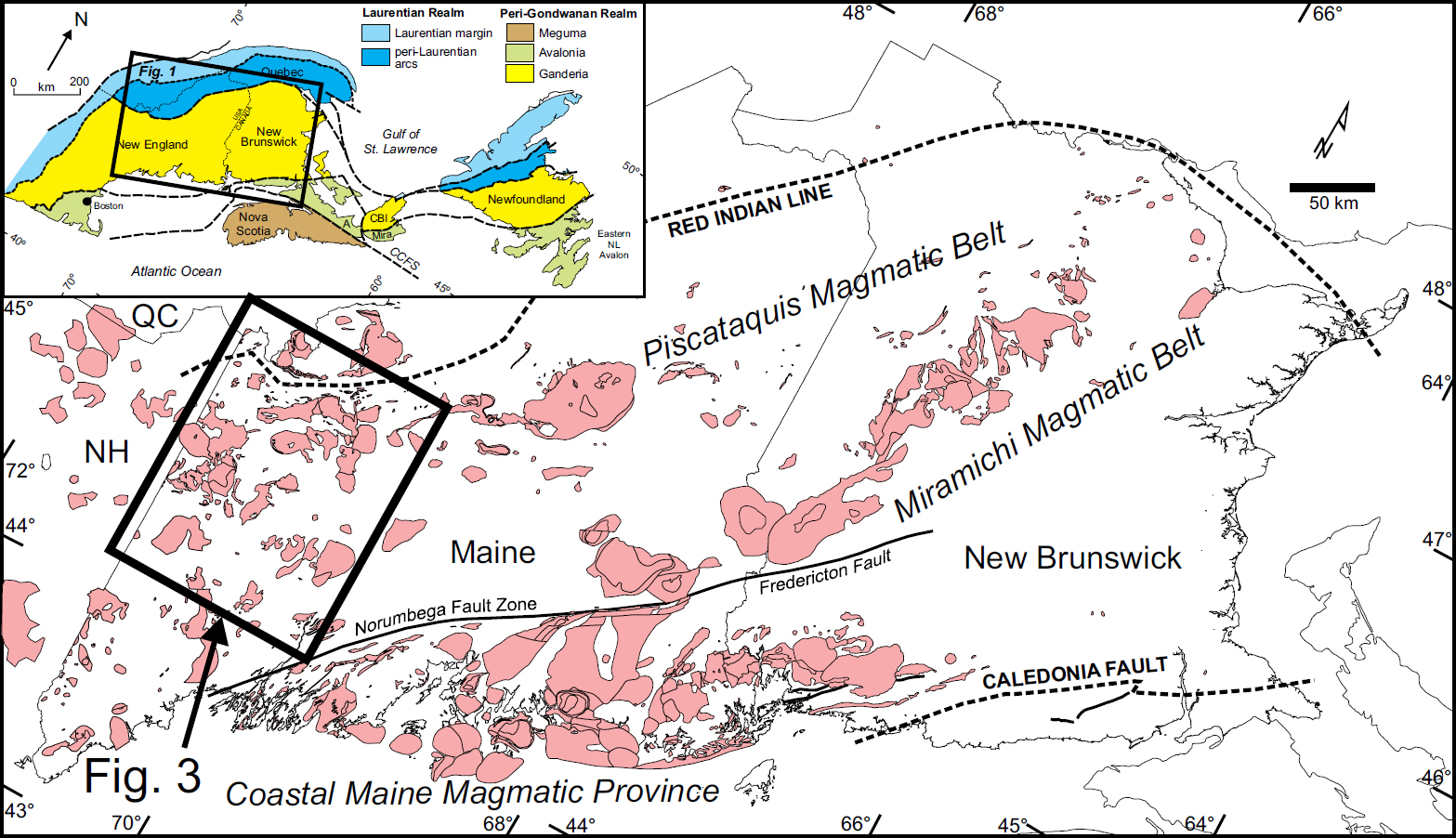 Display large image of Figure 1
Display large image of Figure 1
3 The focus of this contribution is a dense cluster of plutons that outcrop in western and northwestern Maine. They were emplaced at various crustal levels, as suggested by the presence or absence of thermal aureoles, and appear to lack any patterns of age and tectono-magmatic correlation. This apparent lack may be due at least in part to the range of methodologies used to date them (U–Pb zircon, 39Ar/40Ar and Rb–Sr), and/or the extent of intra-pluton petrographic variation, and the fact that some plutons remain undated. We present new LA-ICP-MS ages for a number of these plutons to examine the duration of magmatism in this part of the orogen, enable correlations between the timing of magmatism and possible sources to be investigated, and further elucidate the nature of this prolonged magmatic event(s) – was it continuous or pulsatory? In many ways these plutons are a microcosm of “Acadian” (sensu latto) magmatism and may further enhance our understanding of the tectonomagmatic environment in the broader Acadian context.
GRANITOID PLUTONS IN MAINE
4 Silurian and Devonian plutonic rocks are scattered throughout Maine and New Brunswick but mainly occur in three belts (Fig. 1). The Coastal Maine Magmatic Province (CMMP) of Hogan and Sinha (1989) outcrops south of the Norumbega Fault Zone and extends into southern New Brunswick to include the Saint George Batholith (Mohammadi et al. 2017). Plutons in east-central Maine appear to be the southwestern extension of the Miramichi Magmatic Belt in New Brunswick, although it is not clear whether or not those plutons extend south of the Norumbega fault to merge with the CMMP (Fig. 1). The third belt of plutons form a scattered trend across north-central Maine into northern New Brunswick, defining the Piscataquis Magmatic Belt (Pilote et al. 2011; Gibson et al. 2006), located south of the inferred boundary between peri-Laurentian and peri-Gondwanan terranes known as the Red Indian Line (Fig. 1).
5 Based on a compilation of available geochronological data (Bradley et al. 2000; Pilote et al. 2011), one-third of the approximately 170 reliable U–Pb zircon ages from Silurian and Devonian plutons in Maine, eastern New Hampshire, and New Brunswick (area shown in Figure 1) have Silurian to earliest Devonian ages between 444 and 416 Ma (Fig. 2). These plutons vary from metaluminous to peraluminous and peralkaline compositions and intruded mainly south of the Norumbega Fault Zone in Maine extending into southwestern New Brunswick and the Miramichi Magmatic Belt of central and northern New Brunswick. They are generally attributed to the Salinic orogeny. A second group, about 40% of dated plutons, have early to middle Devonian ages of ca. 415–395 Ma (Fig. 2). These rocks also vary considerably in composition and intruded mainly throughout the Piscataquis Magmatic Belt in northern and western Maine and into eastern New Hampshire. The remaining one-third of the ages are middle to late Devonian age (ca. 390–360 Ma) and are from plutons scattered throughout New Brunswick, Maine, and eastern New Hampshire. These Devonian plutons have often been termed “Acadian” and “Late Acadian” in the literature (Fig. 2). Their distribution shows no clear pattern in space and time, and the wide geographic separation of some contemporaneous plutons suggests that they are not all related to a specific or the same orogenic event.
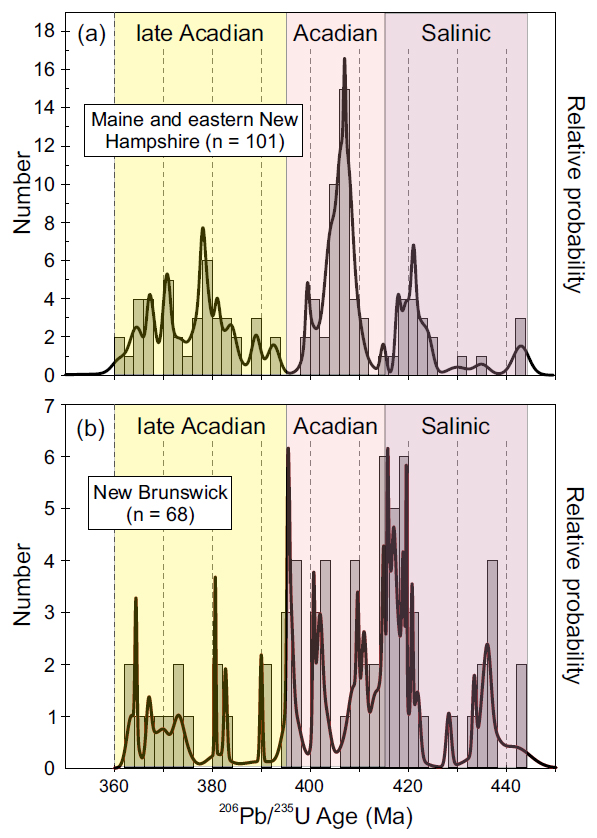 Display large image of Figure 2
Display large image of Figure 2
6 Pluton ages in the Coastal Maine and Miramichi belts are reasonably well constrained, but this is not the case for plutons in western Maine, where the broad distribution of varied plutons is especially enigmatic. Some of these plutons are the focus of the present study (Fig. 3).
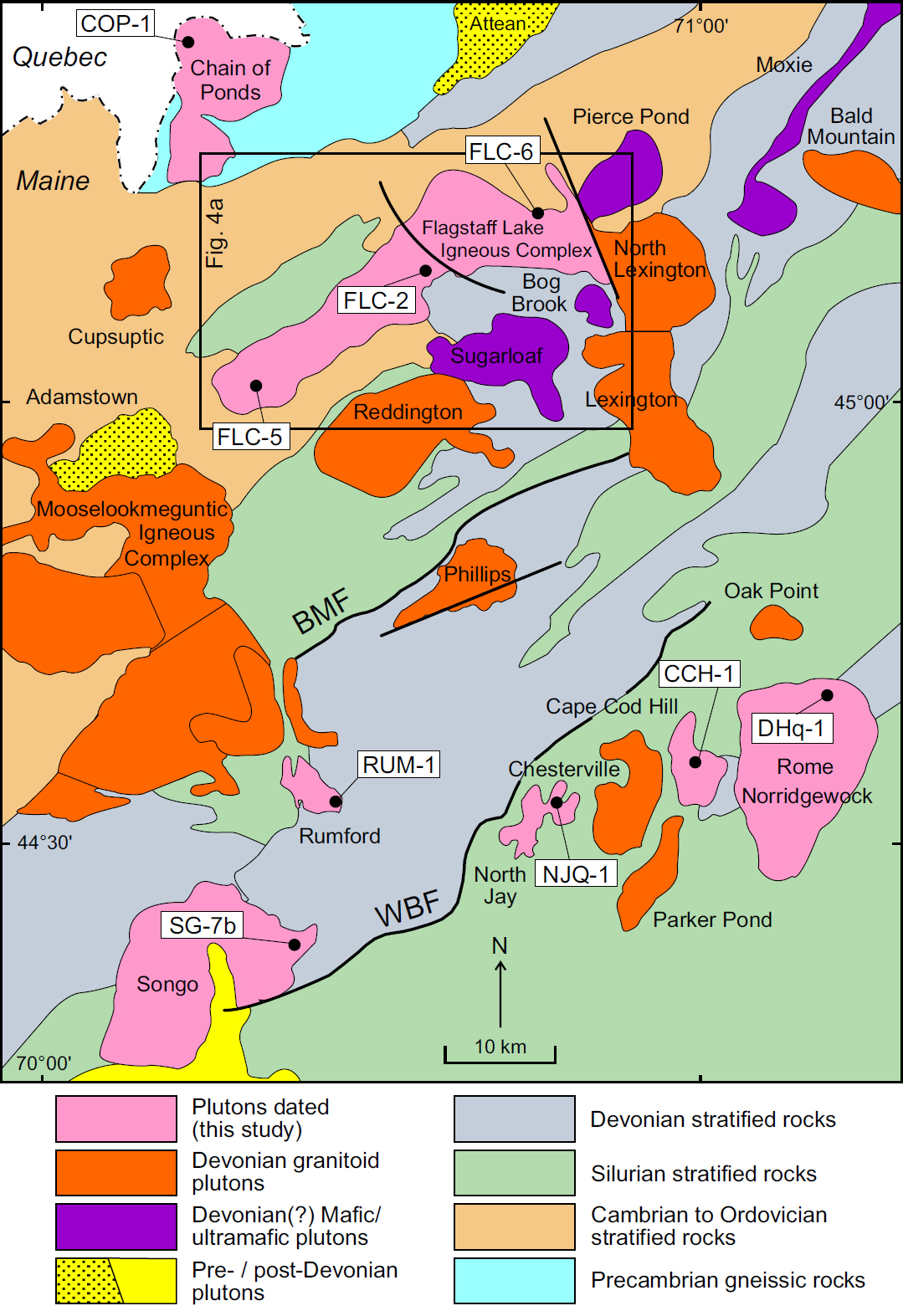 Display large image of Figure 3
Display large image of Figure 3
FIELD RELATIONS AND PETROGRAPHY
7 The plutons dated in this study are in northwestern Maine bordering with Quebec in the north and New Hampshire in the west (Fig. 3). They intruded a variety of country rocks with ages from Precambrian to Devonian and vary in mineralogy and emplacement form. Both I- and S-type compositions are evident, in some cases forming different units of the same intrusion, such as in the Mooselookmeguntic Igneous Complex and the Lexington composite pluton (Tomascak et al. 2005). Field relationships suggest that some of the plutons may be high-level ring-dike intrusions whereas others are deeper level sill-like or tabular intrusions. Both zoned and composite intrusions are present, although the lack of exposure in many areas precludes evidence from internal contacts to definitively determine which. Most, if not all, of these plutons truncate either major stratigraphic and/or structural boundaries, suggesting that they were emplaced after crustal assembly in this part of the northern Appalachian orogen.
8 The Mooselookmeguntic Igneous Complex (MIC), the Redington and Phillips plutons and the Lexington composite pluton in northwestern Maine have been dated previously by the U–Pb zircon method (Tomascak et al. 2005; Solar et al. 1998). As summarized in Table 1, these plutons display petrographic and compositional characteristics similar to those of the plutons described below which were dated in this study.
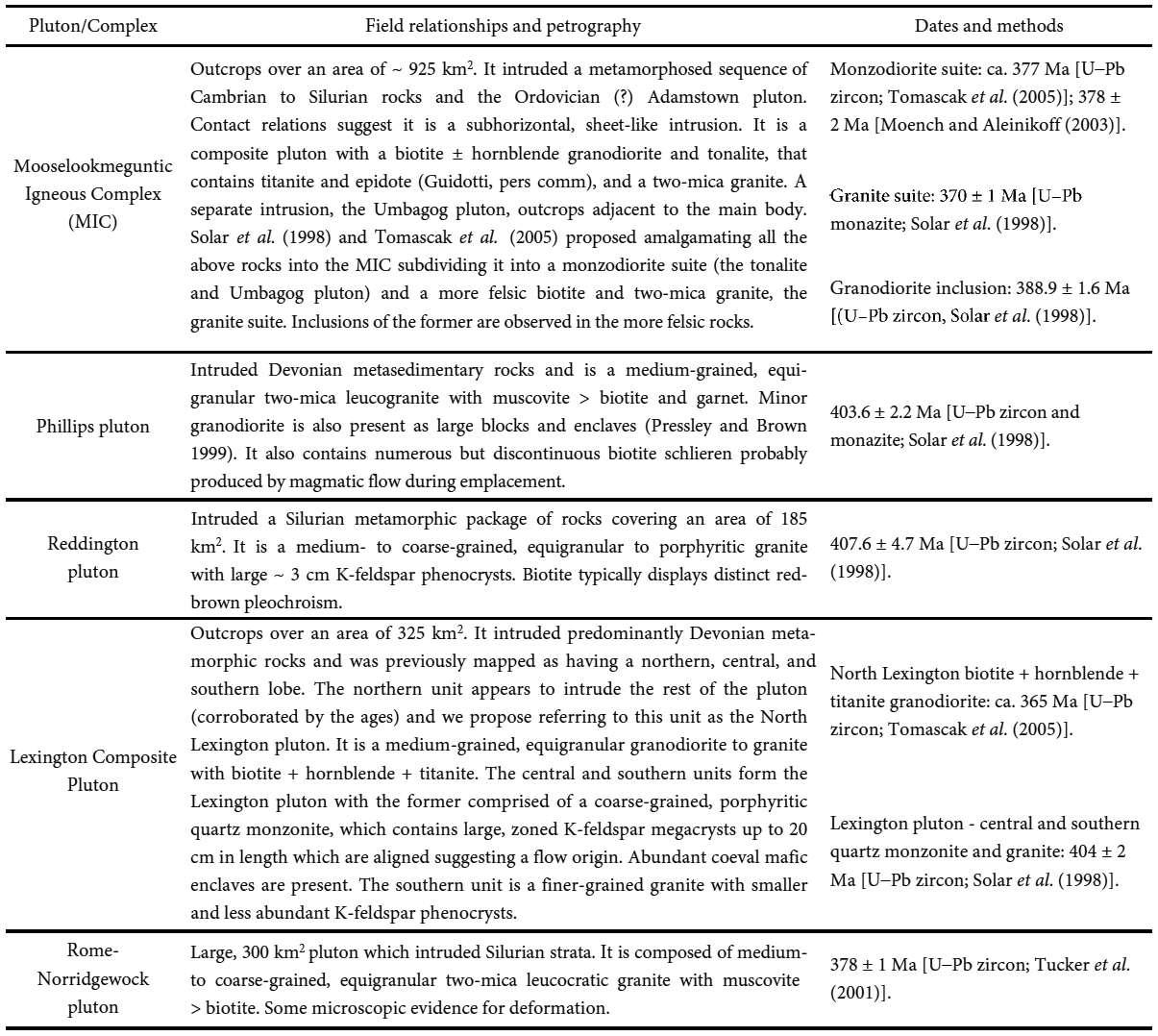 Display large image of Table 1
Display large image of Table 1
Chain of Ponds pluton
9 The Chain of Ponds (COP) pluton outcrops over approximately 220 km2 in northern Maine and extends northward into Quebec (Fig. 3). It intruded Precambrian basement rocks of the Chain Lakes massif, and is mapped as two granitoid bodies, the most northerly of which is zoned with a core of biotite-hornblende granite and a marginal zone of biotite granite. Several “screens” of country rock outcrop within both units in a semi-circular concentric outcrop pattern parallel to the outer contact of the intrusion (Harwood 1973). Westerman (1980) mapped a large number of brittle fractures, which together with the outcrop relationships suggest that the intrusion has a high-level ring dike form. A few kilometres to the north in Quebec, the Spider Lake pluton is similarly zoned but due to lack of exposure its relative age relationship to the COP pluton is unclear. The COP pluton was dated by Heitzler et al. (1988) using the 40Ar/39Ar hornblende step-heating technique which yielded an age of 373 ± 2 Ma based on the average of 6 plateau ages. The Spider Lake pluton gave a U–Pb zircon age of 383 ± 3 Ma (Simonetti and Doig 1990).
10 Dated sample COP-1 was collected from the northerly zoned part of the COP pluton close to the Quebec border. It consists of equigranular, medium-grained biotite granite with a colour index (CI) ~20. Biotite is the predominant mafic mineral and occurs as euhedral flakes 2–3 mm in size. It has pale brown to dark brown pleochroism with numerous zircon inclusions. Minor hornblende is also present. Plagioclase forms larger euhedral grains, up to 4 mm in length, commonly displaying compositional zoning, and is more abundant than K-feldspar. Some grains show minor sericitic alteration. K-feldspar occurs as mostly interstitial, anhedral grains. Quartz occurs as anhedral grains, commonly in clusters (glomerocrysts), with some grains displaying undulatory extinction. Zircon is the most abundant accessory mineral and is hosted predominantly in biotite. Some larger grains, up to 0.25 mm, are present. In addition, opaque minerals and titanite are present. Some epidote grains are also observed and their euhedral and zoned, suggesting a possible magmatic origin.
Flagstaff Lake Igneous Complex
11 The Flagstaff Lake Igneous Complex (FLIC) is one of the largest intrusions (420 km2) of the central/northern Maine belt outcropping from Rangeley to the Long Falls Dam, about 60 km in an orogen-parallel SW–NE direction (Fig. 4a). It intruded Cambrian–Ordovician rocks along its northern border and an Ordovician–Silurian metasedimentary sequence along its southern margin and has not been previously dated. Moench and Pankiwskyj (1988) mapped the complex as a composite intrusion composed of three units, from southwest to northeast: gabbro with garnet “granofels”, a central area of porphyritic granite, and gabbro in the northeast. Neilsen et al. (1989) described more complex field relations including garnet tonalite (as opposed to granofels) and evidence for the comingling/mixing of mafic and felsic magmas especially in the gabbroic area in the northeast of the complex. However, the reconnaissance fieldwork for this study has revealed further variations. The southwestern unit, although predominantly gabbro, also contains diorite and granite in close field association. Similarly, the central unit is petrographically variable with coarse-grained, porphyritic granite in contact with fine-grained quartz diorite (Fig. 4b). The contact is sharp, defined by a thin (<1 cm) biotite-rich zone, but it does not appear to be a chilled, intrusive contact. The northeastern unit is predominantly a commingled zone of mafic and felsic rocks. Medium-grained gabbro and diabase are surrounded by, and in lobate contact with, intermediate “hybrid” rocks and granitic material (Figs. 4c, d). Some quartz and feldspar grains are observed in the mafic rocks whereas some mafic minerals (hornblende?) exchanged to the felsic portion. Acicular apatite, formed by quenching during magma mixing, was observed microscopically in intermediate rocks, although evidence of more intensive mixing, such as rapakivi-textured feldspars or quartz ocelli, is absent. It is clear however, that these mafic and felsic magmas were contemporaneous.
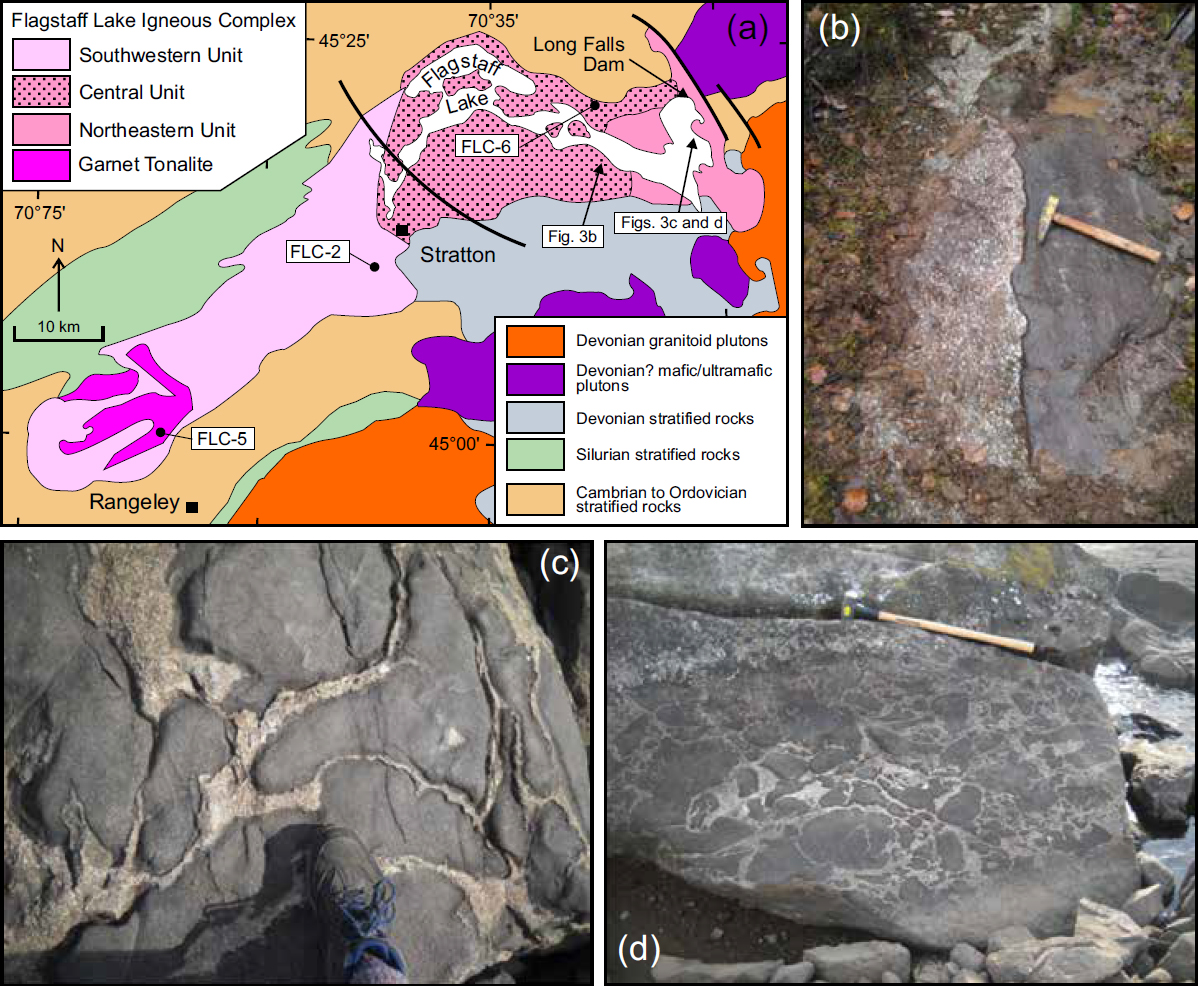 Display large image of Figure 4
Display large image of Figure 4
12 A particularly enigmatic rock type observed in the FLIC is garnet tonalite, which outcrops both in the southwestern part of the complex and near its northeastern contact. Nielsen et al. (1989) suggested two possible origins for these rocks — either by the differentiation of mantle-derived magma or by country rock anatexis. They pointed to the close association of the garnet tonalite with sulfidic, Fe-rich metapelite as an important petrogenetic observation. However, either process would have required significant heat input and therefore determining the age of these rocks might be significant in elucidating the timing of mantle-derived magmatic activity. Three samples were dated from the FLIC: Sample FLC-2 is equigranular, coarse-grained, biotite granite with CI ~15 and was collected from the central unit of the FLIC just west of the town of Stratton. The dominant mafic mineral is biotite which displays distinctive pale to deep red-brown pleochroism. It forms euhedral grains up to 2.5 mm with minor chloritic alteration along cleavage planes. Muscovite is also present and appears to be primary as it occurs both as discrete grains (Figs. 5a, b) and as inclusions in both K-feldspar and plagioclase. K-feldspar occurs as large (up to 5 mm) euhedral to subhedral twinned grains showing perthitic texture. Quartz is more abundant than plagioclase with some grains being up to 4 mm in length and locally displaying undulatory extinction. Plagioclase forms subhedral to anhedral grains which are interstitial or larger, up to 4 mm, some of which display concentric zoning. Zircon is again the dominant accessory phase occurring as small equant grains <0.2 mm in size, although some acicular forms are also present. Minor amounts of apatite are also observed.
13 Sample FLC-5 was collected from workings at an abandoned garnet quarry at the southwestern end of the FLIC. The rock is equigranular, medium-grained and dominated by garnet which comprises over 60% of the sample. The garnet occurs as mostly euhedral to subhedral grains which range in size from 2–3 mm (Fig. 5c) and contain numerous opaque inclusions. Most are fractured in a consistent orientation. Biotite is the dominant mafic mineral and is commonly around the margins of the garnet grains. It displays pale red to deeper red-brown pleochroism. Plagioclase forms subhedral grains between the garnet grains and typically displays concentric zoning, supporting an igneous origin for this rock (Fig. 5d). Quartz occurs interstitially as small (<1 mm) grains that show normal (non-undulatory) extinction. The main accessory phases are zircon, hosted by the biotite, and opaque minerals, which are generally observed within the garnet grains.
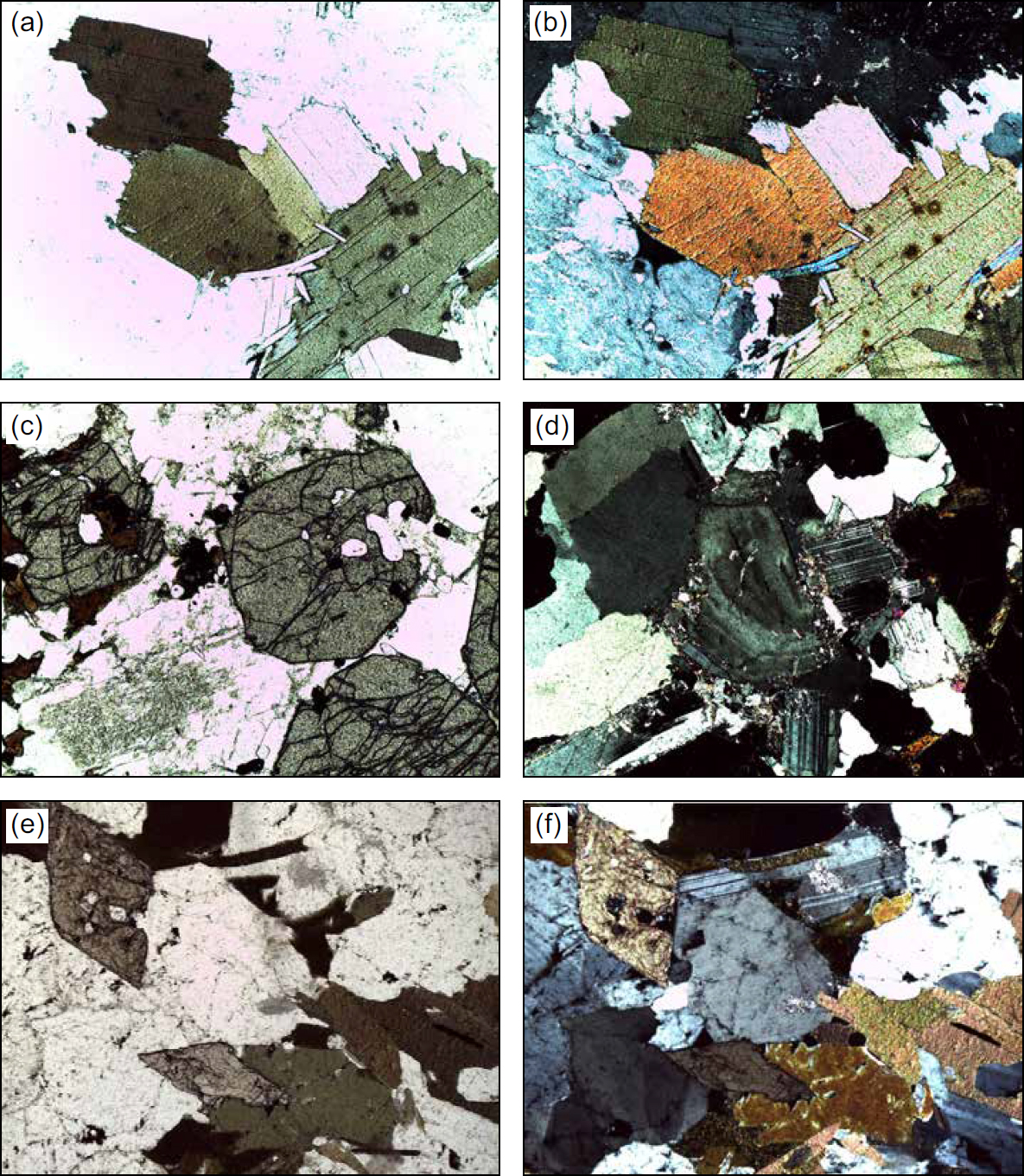 Display large image of Figure 5
Display large image of Figure 5
14 Sample FLC-6 was collected from the northeastern part of the FLIC just inland from the northern shoreline of Flagstaff Lake. It is a medium-grained, mainly equigranular biotite granite with a CI ~25. Biotite occurs as small, euhedral flakes up to 2 mm wide with some minor chloritic alteration. It displays pale to deeper red-brown pleochroism and hosts abundant zircon grains. Muscovite is also present and is interpreted to be mostly of primary origin, although it also occurs as an alteration product. Plagioclase is more abundant than K-feldspar and some larger grains, up to 4 mm, are present. Most plagioclase forms smaller euhedral to subhedral grains with sericitization of core areas suggesting higher Ca contents. K-feldspar is typically subhedral and around 4 mm across with quartz about the same size, the latter displaying normal extinction. Zircon is the dominant accessory phase with minor amounts of opaque minerals.
Rumford pluton
15 The Rumford pluton, mapped by Moench and Hildreth (1976), is a small, composite intrusion which outcrops over an area of 25 km2 but is poorly exposed in a bowl-shaped topographic depression. It intruded mostly Devonian metasedimentary rocks but also some Silurian strata to the northwest and therefore cross cuts an important structural boundary, the Blueberry Mountain fault (Fig. 3). Moench and Hildreth 1976) mapped a number of rock types in the Rumford pluton. An area of gabbro-diorite with hornblende, biotite, and calcic plagioclase occurs in the western part of the intrusion. The main part of the pluton is more felsic with equal areas of pegmatitic granite and two-mica granite. The pegmatitic granite texture ranges from true pegmatite to aplite with minor garnet and tourmaline. The two-mica granite contains abundant inclusions of granodiorite and tonalite which contain biotite and hornblende with some titanite and zircon, and are similar to rocks in the Mooselookmeguntic Igneous Complex (Table 1).
16 Sample RUM-1 was collected from the eastern margin of this petrographically diverse pluton. It is a medium-grained, medium-grey equigranular granite. It has a CI of ~20 with biotite as the main mafic mineral and sparse hornblende. The biotite occurs as euhedral flakes 2–3 mm in length. Glomerocrystic quartz is abundant, and plagioclase predominates over K-feldspar. Opaque minerals and rare zircon and apatite are present as accessories but no titanite was observed.
Songo pluton
17 Outcropping over an area of 325 km2 the Songo pluton (Fig. 3) intruded a high-grade Devonian metasedimentary sequence, which was metamorphosed to K-feldpsar + sillimanite grade (Guidotti et al. 1986 and references therein). The estimated depth of emplacement is ~18 km based on new Al-in-hornblende data (Brock and Gibson, unpublished data) using the calibration method of Mutch et al. (2016). The Songo pluton previously yielded a U–Pb zircon age of 382 ± 3 Ma (Lux and Aleinikoff 1985); however, a younger age of 360.7 ± 2.2 Ma was reported by Eusden et al. (2020). It is intruded by numerous two-mica leucocratic granite and pegmatite bodies, which range in age from Carboniferous to Permian (Solar and Tomascak 2016). These bodies have played an important role in the development of petrographic variants within the Songo pluton (Gibson et al. 1989). Typically, the Songo pluton consists of equigranular, coarse-grained biotite + hornblende + titanite granodiorite to granite with some quartz diorite and is undeformed. However, more proximal to the granite/pegmatite intrusions the granite displays a well-defined fabric, which can be intensely developed to gneissic at its extreme. In addition, hornblende is absent and the biotite has the red-brown pleochroism indicative of high Ti content common in metamorphic varieties (Deer et al. 1966). This variation could be related to the forceful emplacement of the younger Carboniferous–Permian leucogranite and pegmatite or perhaps the deformed rocks are vestiges of an older pluton. Recent remapping of the Bethel (Eusden et al. 2020) and Waterford quadrangles (C. Koteas, personal communication 2020) have further highlighted the variable petrography evident in the Songo pluton.
18 Dated sample SG-7b was collected from the northeastern lobe of non-foliated Songo pluton granodiorite. It is an equigranular, medium-grained biotite + hornblende + titanite granodiorite with a CI of ~25 (Figs. 5e, f). Biotite occurs as euhedral grains up to 2.5 mm in diameter and is more abundant than hornblende. It displays pale brown to greenish-brown pleochroism and has minor chloritic alteration along cleavage planes. Minor hornblende occurs as subhedral grains with light to dark green pleochroism. Plagioclase is more abundant than K-feldspar and occurs as ~4 mm subhedral grains, some of which display compositional zoning. K-feldspar forms interstitial subhedral grains up to 4 mm across. Quartz is typically in clusters, with individual grains not exceeding 2 mm across and displays normal extinction. Accessory phases include euhedral titantite grains up to 2.5 mm in length and a lesser amount of zircon forming inclusions in biotite.
West-central Maine plutons
19 A group of four peraluminous two-mica plutons outcrop in west-central Maine, from west to east the North Jay, Chesterville, Cape Cod Hill, and Rome-Norridgewock plutons (Fig. 3), following the nomenclature proposed in Gibson et al. (2006). They intruded an older Silurian metasedimentary succession in a different crustal block than the plutons described above and previously dated plutons (Table 1). They are separated from these plutons by a major structural boundary, the Winter Brook fault, which was interpreted by Moench and Pankiwskyj (1988) “as a west-verging older- over-younger thrust”. The Rome-Norridgewock pluton has an overall ovoid outcrop pattern and is exposed over an area of 260 km2, whereas the North Jay (40 km2), Chesterville (85 km2), and Cape Cod Hill (50 km2) plutons have more irregular outlines but still truncate the regional NE-SW orogen trend. The Chesterville pluton is poorly exposed and intensely weathered and was therefore not sampled for the present study. However, it appears to be petrographically similar to both the North Jay and Cape Cod Hill granites.
North Jay pluton
20 The North Jay pluton consists of light grey, medium-grained, equigranular muscovite - biotite granite with minor amounts of garnet. It is intruded by several metre-sized pegmatite dikes along with aplitic segregations, which also contain garnet and minor beryl. Abundant metasedimentary xenoliths, that range from large blocks (10–20 cm) to small, thin slivers or surmicaeous enclaves, are also observed. They are obviously of metamorphic origin with garnet and biotite in schistose fabric. Small (1–2 cm) clots of biotite and garnet may represent further disaggregation of the xenoliths. These garnets are euhedral (Fig. 6a) and electron microprobe data reveal that they are chemically zoned in Ca, Mg, Mn, and Y contents (Gibson et al. 2006). However, another population of subhedral to anhedral garnet (Fig. 6b), which lacks chemical zoning, is also present. Although the majority of garnet in the North Jay granite is most likely xenocrystic due to the abundance of metamorphic xenoliths, some is magmatic in origin (Gibson et al. 2006).
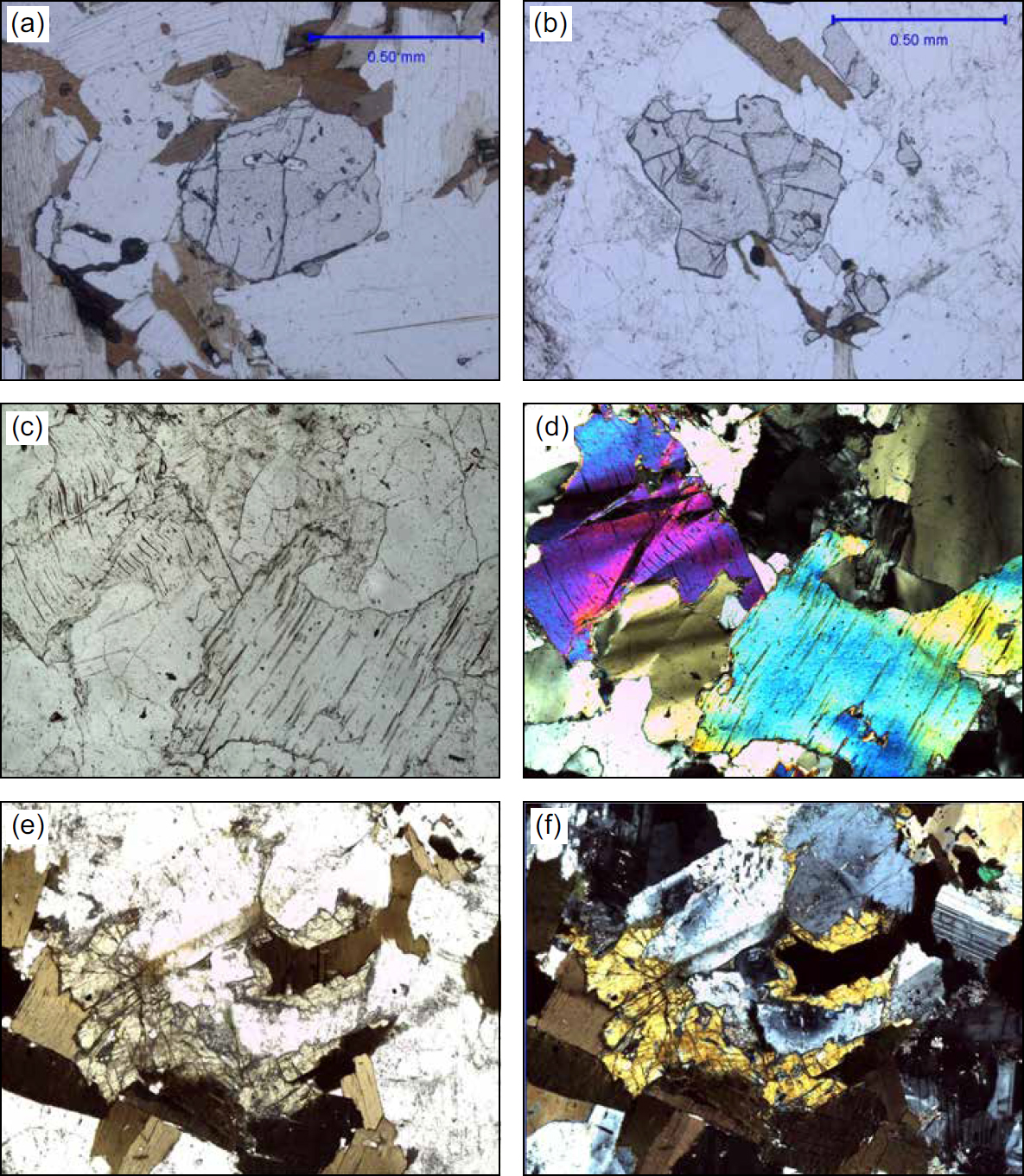 Display large image of Figure 6
Display large image of Figure 6
21 Dated sample NJq-1 was collected from the North Jay granite quarry and is fine- to medium-grained, equigranular two-mica leucocratic granite with a CI ~12. Biotite is slightly more abundant that muscovite. It has pale brown to deeper red-brown pleochoism with numerous zircon inclusions. Muscovite is of primary origin with some large euhedral grains present. Quartz occurs as anhedral grains in clusters and displays evidence of deformation with undulatory extinction and serrated margins. Plagioclase forms subhedral grains up to 2.5 mm in length and some have concentric zoning. K-feldspar (microcline) is common, both as discrete and interstitial grains. Zircon is the dominant accessory mineral but acicular opaque minerals and some garnet grains are also present.
Cape Cod Hill pluton
22 The Cape Cod Hill (CCH) pluton forms the elevated topography to the south of Farmington and is mapped as a roughly oval body that cuts across the regional NE–SW trend (Fig. 3). It is composed of a medium-grained, white, equigranular granite with minor garnet. It has a similar range of xenoliths as the North Jay pluton and petrographically the two are similar. However, viewed in thin section the CCH granite displays more pronounced deformation features.
23 Dated sample CCH-1 was collected from the Cape Cod Hill quarry and is an equigranular, medium-grained two-mica leucocratic granite with a CI of 5. Biotite is sparse and occurs as sub- to anhedral grains < 1 mm in size with pale brown to deeper red-brown pleochroism. Zircon inclusions are common and many grains display warped cleavage planes indicating some post-crystallization deformation. Muscovite is more abundant than biotite with larger euhedral grains up to 2.5 mm. Like the biotite grains, muscovite grains show warped and disjointed cleavage planes (Figs. 6c, d). Quartz occurs as 2 to 2.5 mm grains that show undulatory and sectorial extinction and many with irregular serrated margins. Plagioclase commonly contains numerous muscovite inclusions and generally lacks zoning. Plagioclase grains vary in size but some are ~3 mm in length and twin planes are warped and broken. Microcline is also present most commonly in anhedral, interstitial grains. Zircon is the most common accessory mineral.
Rome-Norridgewock pluton
24 The Rome-Norridgewock (R-N) pluton is the largest pluton of the west-central Maine group covering an area of 260 km2 and is mapped as a homogeneous granitic intrusion on the bedrock map of Maine (Osberg et al. 1985). However, sampling for an 40Ar/39Ar cooling history study (Gibson et al. 2006) revealed a petrographically different unit in the northeastern part of the pluton south of the town of Norridgewock. The main unit of the pluton is light grey, medium- to coarse-grained equigranular granite with both biotite and muscovite. This rock type forms most of the pluton and closely resembles the CCH and North Jay granites; hence we refer to it as the Rome unit of the R-N pluton in this paper. The only previous age determination on any of the plutons in west-central Maine was from this unit and yielded a U–Pb zircon age of 378 ± 1 Ma (Tucker et al. 2001).
25 The petrographic variant exposed in more northerly outcrops of the R-N pluton is medium-grained, equigranular, biotite ± hornblende + titanite granite/granodiorite, and hence of I-type mineralogic affinity (Chappell and White 2001) in contrast to the two-mica Rome unit described above. This unit is referred to as the Norridgewock unit. No contact relationships were observed, so it is unclear if the Norridgewock unit is a comagmatic part of the R-N pluton or if it should be considered a separate intrusion.
26 Dated sample DHq-1 was collected from the Dodling Hill quarry which is located in the Norridgewock unit of the RN pluton. It is equigranular, medium-grained biotite + horn-blende + titanite granite/granodiorite with a CI of ~15 (Figs. 6e, f). Biotite is the dominant mafic mineral and occurs as larger euhedral flakes with pale brown to greenish brown pleochroism. Hornblende forms small subhedral to anhedral grains, typically in mafic knots with biotite. Plagioclase occurs as larger grains, up to 4 mm, that are euhedral to subhedral. Some grains display concentric compositional zoning. K-feldspar forms smaller subhedral crystals. Quartz occurs in glomerocrysts approximately 3 mm in size, some of which display undulatory and sectorial extinction. Zircon and titanite are the dominant accessory phases with minor opaque minerals and allanite also present.
ANALYTICAL METHODS
27 The samples for this study were sent to Overburden Drilling Management (ODM) in Ottawa, Ontario, for electropulse disaggregation and initial zircon separation. Zircon grains for dating were then picked from the zircon concentrates at Cape Breton University in Sydney, Nova Scotia. Selected grains were mounted in an epoxy-covered thin section at the University of New Brunswick, Fredericton, polished to expose the centres of the zircon grains and imaged using cold cathodoluminescence to iden-tify internal zoning and inclusions (Appendix A: Figs. A1 and A2). These images were used to select ablation points (30 µm diameter), avoiding visible inclusions, cracks, or other imperfections.
28 U and Pb isotopic compositions were measured using the Resonetics S-155-LR 193 nm Excimer laser ablation system connected to an Agilent 7700x quadrupole inductively coupled plasma – mass spectrometer in the Department of Earth Sciences at the University of New Brunswick, following the procedure outlined by McFarlane and Luo (2012) and Archibald et al. (2013). Data reduction was done inhouse using Iolite software (Paton et al. 2011) to process the laser output into data files, and further reduced for U–Pb geochronology using VizualAge (Petrus and Kamber 2012). VizualAge outputs included uncorrected U–Pb ratios that were used to calculate 204Pb-based corrections (Andersen 2002) and 208Pb-based corrections. Data were filtered using 204Pb as a monitor. For grains with <80 counts/s 204Pb, data are uncorrected; for grains where the percentage error on the 204Pb counts per second was <20%, we used a 204Pbbased correction (Andersen 2002), and for grains where the percentage of radiogenic Pb (Pb* in file) is less than 98.5% we used a 208Pb-based correction (Petrus and Kamber 2012). After these corrections were applied, data were sorted by concordance (206Pb/238U versus 207Pb/235U), and by the percentage of radiogenic Pb in the grains as calculated using VizualAge. All analytical data are presented in Appendix B, Table B1, with analyses used in concordia calculations highlighted. All data from reference material FC-1 and Plešovice are presented in Appendix B, Table B2.
29 Concordia ages were calculated for clusters of three or more near-concordant points using Isoplot versions 3.75 and 4.15 (Ludwig 2003, 2012). All ages are reported at 95% confidence, with decay-constant errors included in the calculations. Data points included in the concordia calculations and reported here are grains that are 98% to 101% concordant and do not require a correction for common Pb (204Pb < 80 counts per second). By using only uncorrected near-concordant grains that overlap within error we can reduce the possibility of misrepresenting the crystallization age as too young which can happen if grains experienced Pb loss (Dickinson and Gehrels 2010). The approach in this study was to calculate concordia ages using as many grains as possible, and hence the MSWD (mean square of weighted deviates) which measures the amount of scatter in the points used to calculate concordia and the reported probability of concordance could in some cases be improved by using fewer grains. In all cases the calculated concordia ages overlap with the weighted mean ages for the samples using all near-concordant data. 206Pb/238U ages are used in all the probability distribution calculations. Concordia ages obtained for standards during this work were presented in Barr et al. (2018).
RESULTS
Sample COP-1 (Chain of Ponds pluton)
30 Abundant zircon grains separated from sample COP-1 range in size from 20 to 150 µm. Most of the grains are clear and euhedral, with bipyramidal terminations preserved. Grains vary in shape from elongate acicular crystals to rectangular. Most grains display weak fluorescence under cathodoluminescence but oscillatory zoning is present in fluorescent grains. Figure A1 (a–d) shows representative grains (backscatter electron and cathodoluminescence for each) with indistinct zoning in their cores, and clear oscillatory zoning around the edges of the grains.
31 The ages obtained from this sample for grains that are between 98 and 102% concordant (84 out of 129 grains analysed) are mostly in the range between 360 Ma and 400 Ma with no obvious clusters (Fig. 7a). The age distribution is strongly skewed with an older “tail”, indicating that inheritance may be a significant factor in the sample. This interpretation is supported by the presence of a few grains as old as Neoproterozoic (Table B1). The cumulative probability plot (Fig. 7b) displays two peaks, a major one ca. 365 Ma, and a secondary one ca. 385 Ma. There is no clear separation between the peaks but they remain distinct with age bins of 2.5 Ma, 5 Ma, and 10 Ma. It is possible to calculate a weighted mean age of ca. 373 Ma for all the grains that are 98–102% concordant (73 grains) but this result has a high MSWD (14) and clearly does not represent a single mean age for the sample. Similarly, it is not possible to calculate a concordia age for the grains around this age without obtaining unacceptably high MSWD values.
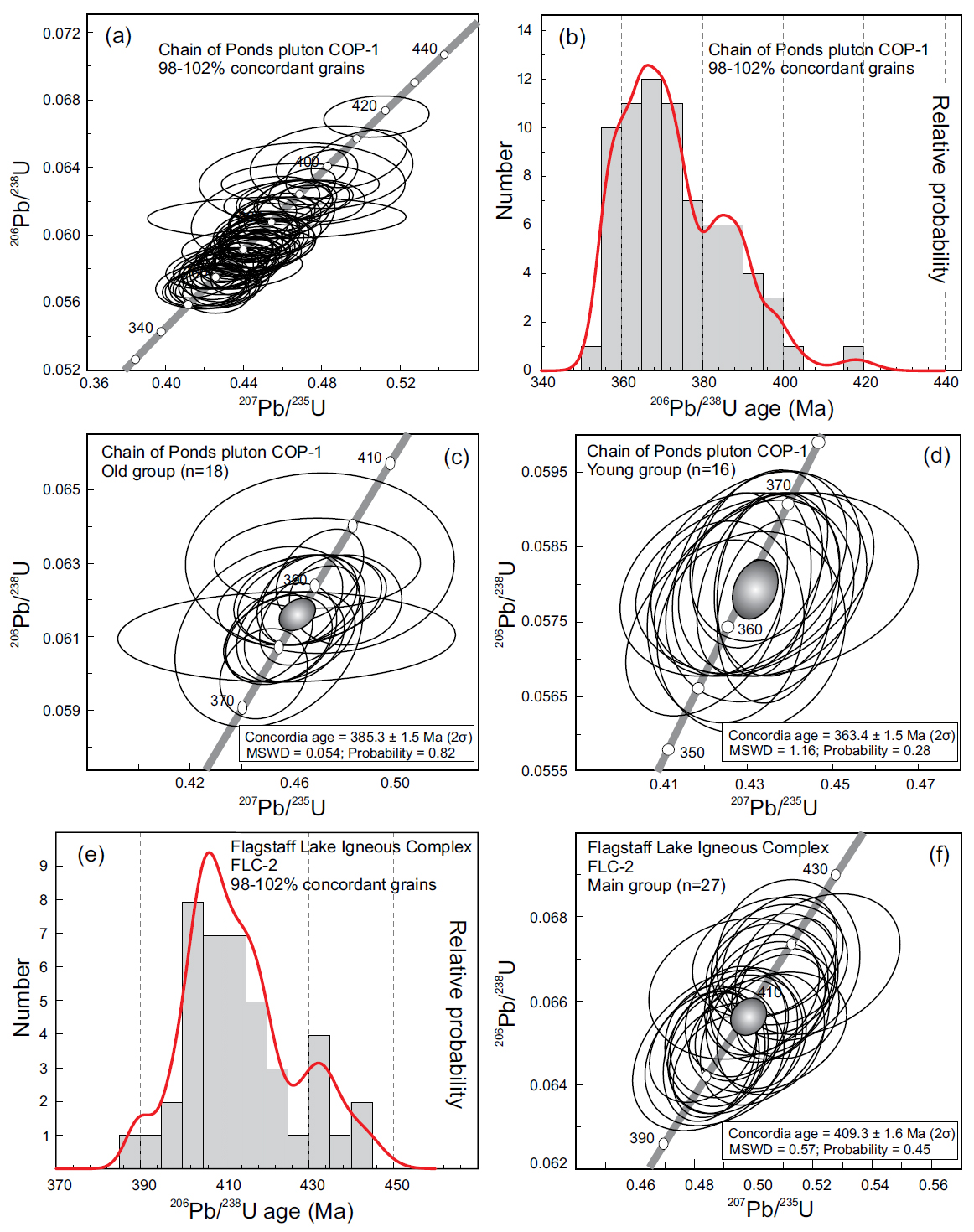 Display large image of Figure 7
Display large image of Figure 7
32 Based on the probability distribution we interpret this sample as having two main age components which can produce concordia ages, an older group (Fig. 7c), and a younger group (Fig. 7d). The younger group has a concordia age of 363.4 ± 1.5 Ma with an MSWD of 1.16, and a probability of concordance of 0.28. The older group has a concordia age of 385.3 ± 1.5 Ma with an MSWD of 0.054 and a probability of concordance of 0.94. Hence, we interpret this sample as having a minimum crystallization age of 363 Ma, with inherited older grains. The wide spread of the near-concordant ages and the presence of older grains in this sample shows that these plutons and the terranes into which they intrude are complex and may represent several episodes of igneous activity. This complexity is also present in other samples and will be discussed in subsequent sections.
Samples FLC-2, 5, and 6 (Flagstaff Lake Igneous Complex, FLIC)
33 The zircon grains from all three FLIC samples are mostly euhedral and clear with few inclusions and the majority of the grains are very small (20 to 150 µm) with only a few grains in the larger range. The smaller grains tend to be acicular in shape, and the larger grains are rectangular, with most showing some oscillatory zoning in cathodoluminescence. Samples FLC-2 and FLC-5 contained abundant zircon, whereas sample FLC-6 had less zircon. However, there are no systematic differences in zircon morphology among the samples and all the grains in all the samples vary in the extent to which zoning is visible, especially in the abundant small grains. Figure A1 (e–h) shows representative grains from FLC-2 (backscatter electron and cathodoluminescence for each) illustrating indistinct zoning (e and f) and non-oscillatory zoning in a smaller grain (g and h). Figure A1 (i–l) shows representative grains from FLC-5 (backscatter electron and cathodoluminescence for each) illustrating variable oscillatory zoning (i and j) and non-oscillatory zoning in a smaller grain (k and l). Figure A1 (m–p) shows representative grains from FLC-6 (backscatter electron and cathodoluminescence for each) illustrating non-oscillatory zoning (m and n) and variable oscillatory zoning in a larger grain (o and p). The images of the smaller grains also illustrate the difficulty in analysing these grains where it is impossible to limit the laser spot to only one zone even if imaging indicates zoning is present because the grains are so small. The ages obtained from the samples differ and hence the samples are discussed separately below.
34 Sample FLC-2 is the least complicated of the three FLC samples. It has a clear peak in the cumulative probability diagram using all the 98–102% concordant grains (38 out of 57 grains analysed) (Fig. 7e) and has a strong right-tailed distribution with a small secondary peak around 430 Ma, interpreted as a result of inheritance. The concordia age with 25 grains is 409.3 ± 1.6 Ma with an MSWD of 0.57, and a probability of concordance of 0.45 (Fig. 7f).
35 Sample FLC-5 has two peaks in the cumulative probability diagram (Fig. 8a), both of which can be seen in a weighted mean plot of the 98–102% concordant grains (25 out of 53 grains analysed). The older group (6 grains) has a concordia age of 401 ± 1 Ma with an MSWD of 1.8, and a probability of concordance of 0.18 (Fig. 8c) and the younger group (10 grains) has a concordia age of 383.8 ± 2.2 Ma with MSWD of 2.3 and a probability of concordance of 0.13 (Fig. 8d). While the statistics on these two ages are not very good, they overlap with the weighted mean ages of the two groups of grains, which are 383.2 ± 2 Ma (MSWD = 0.84, probability = 0.58) and 400.3 ± 3.4 Ma (MSWD = 0.33, probability = 0.90), respectively (Fig. 8b).
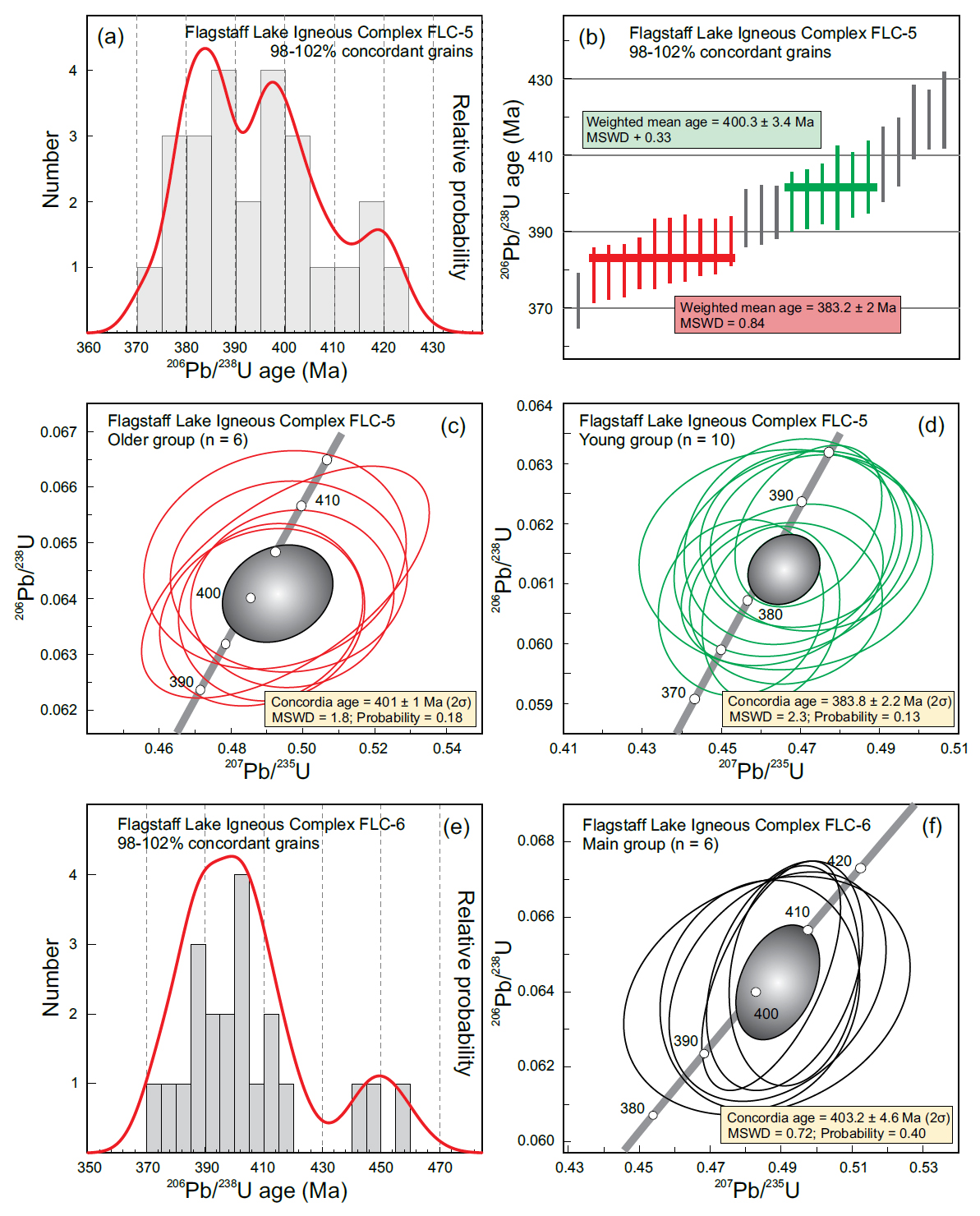 Display large image of Figure 8
Display large image of Figure 8
36 Sample FLC-6 has a single major peak in the cumulative probability diagram (Fig. 8e) of the 98–102% concordant grains (22 out of 58 grains analysed). Using the largest possible group of grains (15) for a concordia age produces an age of 399.9 ± 3.6 Ma with a high MSWD of 4.0, and low probability of concordance of 0.045. The weighted mean age of the same group of 15 grains is slightly younger at 397.5±5.3 Ma with an MSWD of 1.8 and a probability of 0.039. When only the grains in the main peak of the probability diagram are used, they produce a concordia age of 403.2 ±4.6 Ma with an MSWD of 0.72, and a probability of concordance of 0.40 (Fig. 8f). This age includes only 6 grains but given the age distribution in this sample we interpret it as the main age of crystallization. As with the other FLC samples older inherited grains are present as well, in this case ca. 410 Ma and 450 Ma. Given that sample FLC-5 also has a major group of younger grains with an age of ca. 383 Ma, it is possible that the younger grains with an apparent peak ca. 390 Ma seen in the cumulative probability diagram for FLC-6 could be part of a younger episode of crystallization. Alternatively, they could be the result of minor Pb loss.
37 Figure 9 shows the U/Th ratios of all the grains included in concordia or weighted mean calculations for the FLIC samples. Of the three samples from this complex FLC-2 has the oldest calculated age, and also the widest spread in U/ Th ratios. FLC-5 has two main group of grains that were used to calculate the two possible ages for this sample (inheritance vs. crystallization). There is no difference between the U/Th ratios of the older and younger groups and each cluster is a tight grouping (Fig. 9). This result suggests that Pb loss is likely not a factor in generating the younger ages, supporting the interpretation that the older age represents inheritance and the younger one is the crystallization age. The older cluster also overlaps with the ratios from sample FLC-2, providing additional support for the interpretation of inheritance of zircons from the older phase of activity. For FLC-6 the main concordia age for the sample is ca. 400 Ma and those grains have U/Th ratios that again overlap with both sample FLC-2 and with the older group in FLC-5. Figure 9 also includes the U/Th ratios for the younger grains in FLC-6 that were not included in the calculated concordia age and make up the younger tail of the distribution as shown in Figure 8e. These ratios again overlap with those from all the other samples, but their U/Pb ratios obtained from analysis are not concordant enough to define a clear cluster of ages that would support the interpretation of a distinct younger phase of crystallization. This supports the interpretation that the younger grains in FLC-6 are simply part of the normal distribution of data around the most likely crystallization age.
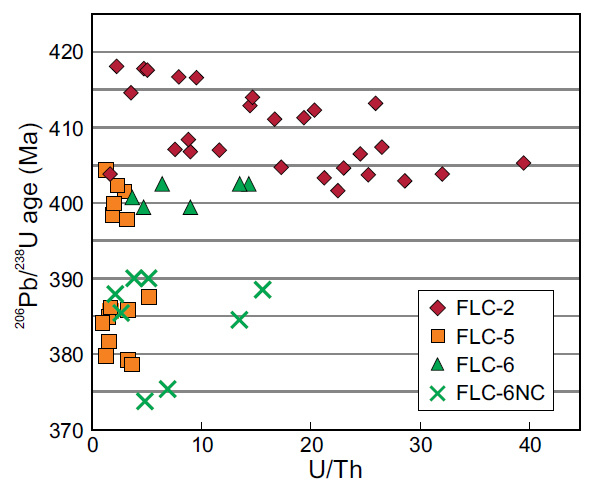 Display large image of Figure 9
Display large image of Figure 9
38 Taken together, the three samples from the Flagstaff Lake Igneous Complex indicate that the complex is a composite pluton containing a large range of inherited ages, and variations in youngest crystallization phases of different segments of the pluton. A major older episode of crystallization at ca. 409 Ma is recorded in sample FLC-2, the major phase for FLC-6 is likely ca. 403 Ma, and sample FLC-5 has a big group of inherited ages ca. 401 Ma, likely derived from the older intrusive units, and a younger episode of crystallization at ca. 383 Ma.
Sample RUM-1 (Rumford pluton)
39 Zircon grains from sample RUM-1 are very small (most under 40 µm) and many were too small to analyse so the total number of data points for this sample is lower than most others. The grains are acicular and most are subhedral to anhedral with reddish-brown surface staining. Under cathodoluminescence most grains showed only weak fluorescence and only some grains showed oscillatory zoning. Figure A2 (a–d) shows representative grains from RUM-1 (backscatter electron and cathodoluminescence for each) illustrating clear oscillatory zoning (a and b) and indistinct oscillatory zoning in a more elongate grain (c and d).
40 Only 7 of 12 grains analysed are between 98 and 102% concordant, but they display a clear peak in the cumulative probability distribution (Fig. 10a). The four grains with ages that overlap within error produce a concordia age of 373.2 ± 2.3 Ma with a MSWD of 0.34 and a probability of concordance of 0.56 (Fig. 10b) interpreted as the main age of crystallization in this sample. Additional concordant grains at ca. 490 Ma are interpreted as inherited.
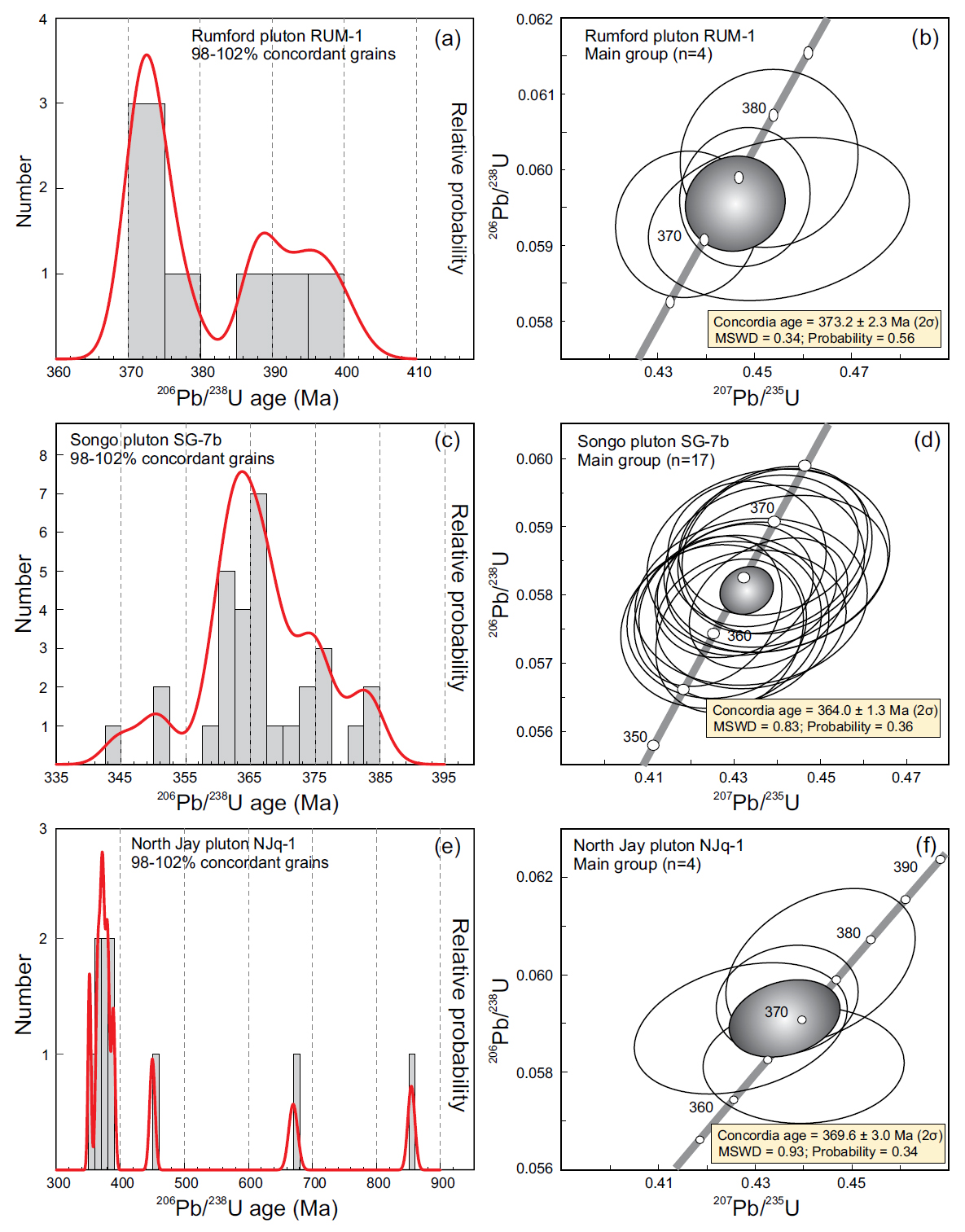 Display large image of Figure 10
Display large image of Figure 10
Sample SG-7b (Songo pluton)
41 Zircon grains in sample SG-7b are mostly euhedral with bipyramidal terminations intact. They are clear and colourless with few visible inclusions and no surface staining. The grains show clear oscillatory zoning under cathodoluminescence. Figure A2 (e–j) shows representative grains from SG-7B (backscatter electron and cathodoluminescence for each) illustrating clear oscillatory zoning seen in grains from this sample.
42 The data for this sample display a major peak in the cumulative probability diagram for the 98–102 % concordant grains (36 out of 51 grains analysed) (Fig. 10c), and a strong right-tailed distribution, with two minor peaks ca. 375 Ma and 385 Ma that can be interpreted as inherited grains. The concordia age of the major peak using 17 grains is 364.0 ± 1.3 Ma with MSWD of 0.83, with a probability of concordance of 0.36 (Fig. 10d).
Sample NJq-1 (North Jay pluton)
43 Zircon grains in sample NJq-1 are very small (most less than 40 µm) and generally acicular and euhedral. Most are clear with few visible inclusions but have brown surface staining. Most of the grains show weak oscillatory zoning under cathodoluminescence. Although the sample contained abundant zircon, most grains are too small to analyse so the total number of data points for this sample is lower than most others. Figure A2 (k–p) shows representative grains from NJq-1 (backscatter electron and cathodoluminescence for each) illustrating that some grains have distinct cores (k–l), some grains have indistinct zoning in cores (m and n), and some have partial oscillatory zoning (o and p), illustrating the variability of zoning observed in this sample. Only 10 out of 25 grains analysed are between 98 and 102% concordant and give a clear peak in the cumulative probability distribution (Fig. 10e). Four grains with ages that overlap within error produce a concordia age of 369.6 ± 3.0 Ma with MSWD of 0.93 and a probability of concordance of 0.34 (Fig. 10f), interpreted as the main age of crystallization in this sample. Additional concordant grains at ca. 450 Ma, 670 Ma, and 850 Ma are interpreted as inherited.
Sample CCH-1 (Cape Cod Hill pluton)
44 Zircon grains in sample CCH-1 are generally acicular and subhedral, with a few euhedral grains. Sizes are varied and range from 20 to 150 µm. Some grains are clear but most have visible inclusions and reddish-brown surface staining. They show very low fluorescence under cathodoluminescence and some of the larger grains show indistinct oscillatory zoning.
45 The cumulative probability distribution of the 98–102% concordant grains for this sample (39 out of 50 grains analysed) shows three distinct peaks (Fig. 11a). Although no clear separations between them is apparent in the probability distribution, it is possible to resolve three separate concordia ages for different groups of grains (Fig. 11b). These groups of grains do not overlap, and neither the concordia ages nor the weighted mean ages overlap within error (Fig. 11c). The youngest group has a weighted mean age of 370.1 ±1.3 Ma with an MSWD of 1.15, the middle group has a weighted mean age of 383.0 ± 2.3 Ma and an MSWD of 2.1, and the oldest group has a weighted mean age of 396.8 ± 2.5 Ma with an MSWD of 0.118.
 Display large image of Figure 11
Display large image of Figure 11
Sample DHq-1 (Rome-Norridgewock pluton)
46 Zircon grains in sample DHq-1 vary from acicular and subhedral, with a few euhedral grains, to subhedral rectangular shapes. Sizes are varied and range from 20 to 150 µm. Some grains are clear but most have visible inclusions and reddish-brown surface staining. The grains in this sample show very low fluorescence under cathodoluminescence and only some of the larger grains show indistinct oscillatory zoning.
47 The cumulative probability distribution of the 98–102% concordant grains for this sample (42 out of 62 grains analysed) shows three distinct peaks (Fig. 11d). Although no clear separations are apparent between them in the probability distribution, it is possible to resolve three separate concordia ages for different groups of grains (Fig. 11e). These groups of grains do not overlap, and neither the concordia ages nor the weighted mean ages overlap within error. The youngest group (18 grains) has a concordia age of 366.2 ± 1.2 Ma with an MSWD of 4.6 and a probability of concordance of 0.031. Since the statistics on this age are not good we prefer to use the weighted mean age for the same group of grains at 365.9±1.5 with an MSWD of 1.4 (Fig. 11f). The middle group has a concordia age of 377.3 ± 1.3 Ma with an MSWD of 1.3 and a probability of concordance of 0.25 (weighted mean age of 376.9 ± 1.4 Ma with an MSWD of 0.96). The oldest group has a concordia age of 388.0 ± 2.1 Ma with an MSWD of 0.54 and a probability of concordance of 0.46 (weighted mean age of 387.8 ± 2.2 Ma with an MSWD of 0.86).
DISCUSSION
48 Magmas produced during collisional tectonic events can be generally assigned to what could be considered as three distinct “end-member” compositions each with a mineralogical/chemical fingerprint of its source: (i) magmas produced by melting of meta- and/or sedimentary upper crustal rocks, which yield peraluminous magmas that crystallize to S-type mineralogies; (ii) deeper level melting of lower crust of igneous/intermediate composition produc-ing I-type mineralogies in the crystallized granitic rocks, and (iii) mafic magmas derived from partial melting of the mantle beneath such subduction/collisional regimes (Pearce 1996; Harris et al. 1986). The latter may serve a dual role in that they may be emplaced as mafic bodies but can also provide the thermal input responsible for the formation of the other two magma types. However, it would be unlikely that pure end-member compositions of these three magma types would be totally preserved during their subsequent crystallization, ascent, and emplacement during the dynamic kinematics of a collisional plate tectonic event. For example, transitional variations are likely with contamination of both S-and I-type magmas. Indeed, more evolved fractionation of the latter could result in some primary muscovite in these rocks, thus resembling less evolved S-type granites. Mantle- derived melts could evolve to more basaltic andesite or andesitic (dioritic) compositions.
49 The concentration of Devonian, broadly Acadian, plutons from northwestern Maine, as described in this paper, is characterized by a petrographically diverse suite of granitoid rocks. They can be assigned to three groups: (i) those that display a typical I-type mineral assemblage of biotite + hornblende + titanite, such as the COP and Songo plutons (Figs. 5e and f) , the Norridgewock unit of the R-N pluton, and the North Lexington pluton; (ii) those plutons that have peraluminous S-type mineralogy with biotite + muscovite together with microcline and apatite, exemplified by the North Jay pluton (Figs. 6a and b), Cape Cod Hill pluton (Figs. 6c and d), and the Rome unit of the R-N pluton; and (iii) a group of biotite granite plutons which contain primary muscovite and high Ti biotite, examples being the Reddington pluton, granitic rocks of the FLIC (Figs. 5a and b), leucogranite of the MIC and most likely the felsic rocks of the Rumford pluton. These plutons are distinct from the S-type granitoids as (i) muscovite is much less abundant,(ii) commonly they are associated with mafic material (ei-ther as contemporaneous magmas such as the northeastern unit of the FLIC or as mafic enclaves), and (iii) metased-imentary xenoliths are rare. They could be considered as “modified” or more evolved I-types comparable to biotite granite of the Main Range of the Malaysia peninsula which has transitional I-S characteristics (Ghani et al. 2013).
50 No pattern in spatial distribution of plutons of each group is apparent in the study area. Although there is a concentration of S-type plutons in west-central Maine south of Farmington (Fig. 3), other two-mica granites, such as the Lexington pluton and units in the MIC further to the north and west, intruded Devonian strata. The west-central Maine plutons intruded Silurian strata and display the most distinct deformational textures at the microscopic scale. The I-type plutons outcrop across the entire area from the COP pluton to the north to the Songo pluton some 150 km to the south and were emplaced at various crustal levels as described above and detailed in Guidotti et al. (1986).
51 Our new ages (Table 2) in conjunction with published ages for other plutons of the area, show that magmatism began in northwestern Maine at ca. 410 Ma and continued to ca. 365 Ma, and hence was a protracted magmatic event(s) of approximately 45 Ma duration, during which compositionally variable magmas were produced. The overall distribution of pluton ages suggests that magmatism was not continuous over this time period but instead that there were breaks or lulls in magma production, for example between 400 Ma and 390 Ma and perhaps as late as 385 Ma (Fig. 12). Whether these breaks are actual or the result of incomplete sampling of plutons in those age intervals is uncertain. However, Miles et al. (2016) reported a similar magmatic hiatus for the Caledonian granites of Britain and Ireland during subduction of the Iapetus Ocean. Possible explanations they discussed include shallow angle subduction or the extensive erosion and removal of the arc.
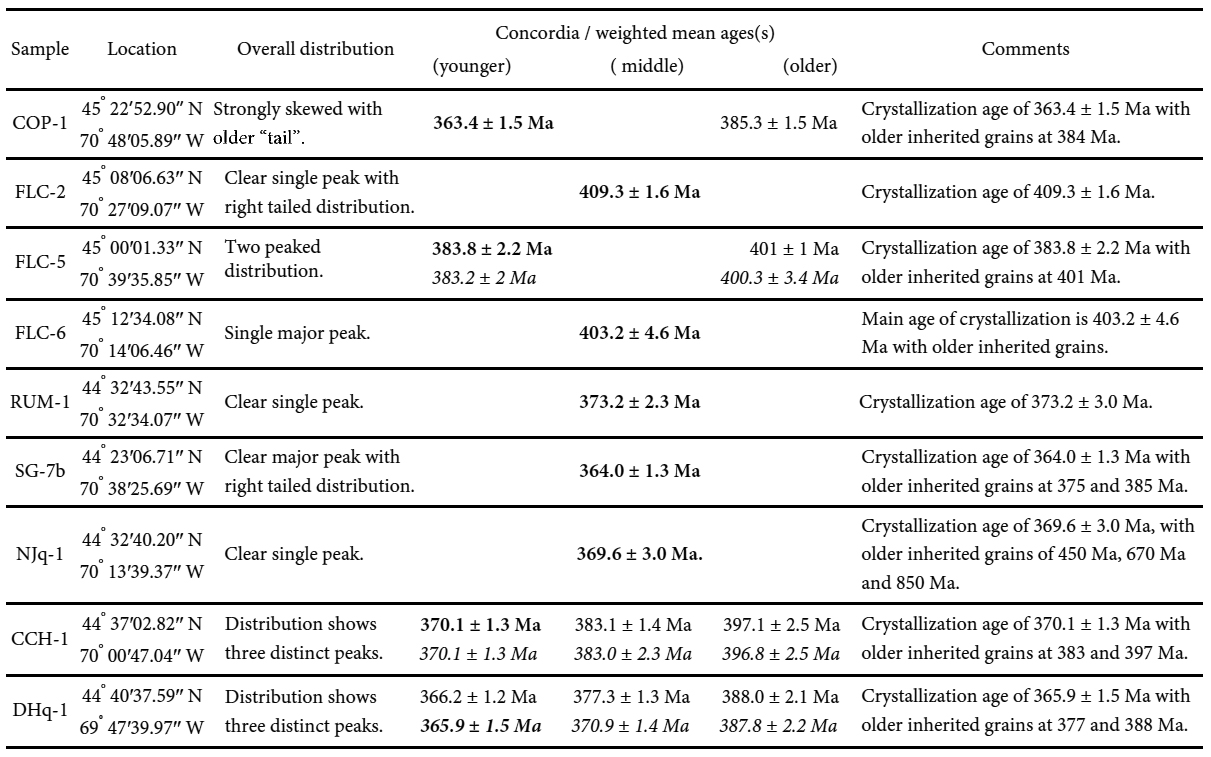 Display large image of Table 2
Display large image of Table 2
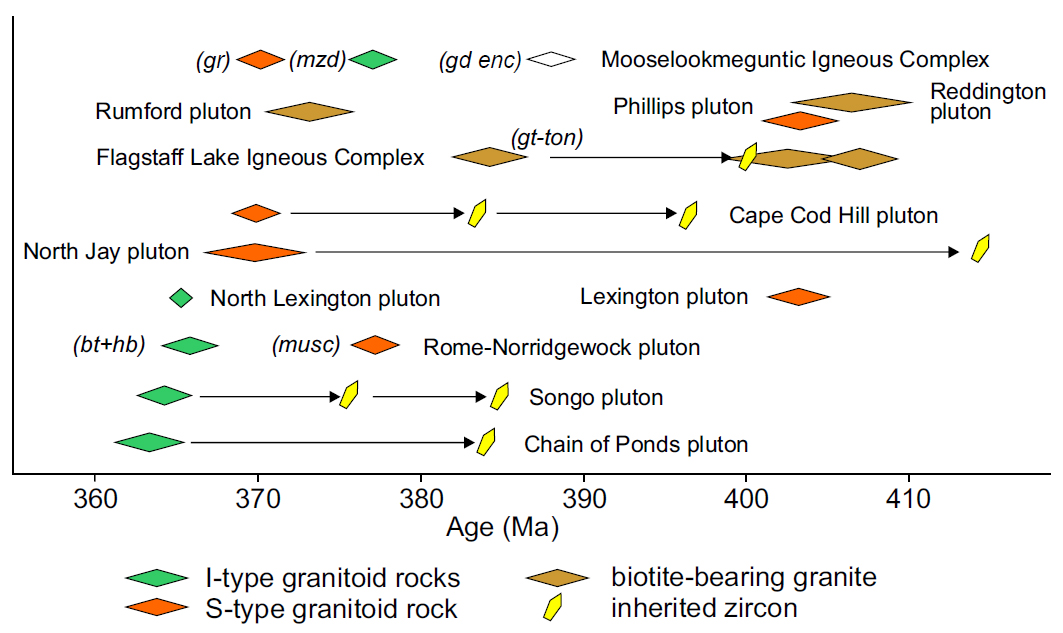 Display large image of Figure 12
Display large image of Figure 12
52 In addition, ages for components in individual intrusions are also variable and point to protracted magmatism at the intra-pluton scale, which is consistent with research on pluton assembly (e.g., Glazner et al. 2004). Ages for the MIC, the Lexington and North Lexington plutons and the Rome-Norridgewock pluton suggest that they were emplaced in temporally distinct magma batches, some of which were separated by 10 to 15 myr. Even the Songo and COP plutons, which yield younger ca. 365 Ma crystallization ages, have evidence through inherited grains of older precursors (Fig. 12) which cluster around 385 Ma.
53 It has been proposed by Bradley et al. (2000) and Bradley and Tucker (2002) that the migrating front of deformation associated with Acadian shortening was located in northern Maine during the Early Emsian (408–406 Ma) but only the FLIC was geographically and temporally close to this front with its ca. 405 Ma age. The FLIC is also the only intrusion in northwestern Maine to contain significant amounts of mafic rocks (Fig. 4c and d). The majority of Devonian plutons in this area were emplaced later, stitching together the already assembled continental crust.
54 The new LA-ICP-MS ages presented here, in combination with previously published data, enable an evaluation of sys-tematic variations in the timing of magmatic activity and the nature of magmas generated across northwestern Maine (Fig. 12). The I-type granites in the COP and Songo plutons yield some of the youngest ages in the area at ca. 365 Ma (Fig. 12). However, the presence of ca. 385 Ma inherited grains in these plutons suggest that they were assembled over a lon-ger timeframe, or sampled ca. 385 Ma rocks in their source area(s) or during magma ascent. Indeed, Lux and Aleinikoff (1985) originally suggested an age of ca. 385 Ma for the Son-go pluton. The I-type granodiorite of the North Lexington pluton also yields an age of ca. 365 Ma, as does the I-type granodiorite of the Norridgewock unit of the R-N pluton (Fig. 12). These ages, (along with the 377 Ma age for the monzodiorite suite of the MIC (Tomascak et al. 2005), bracket the production of a significant volume of I-type magmas in the lower crust between 380–365 Ma in this area. However, I-type magmas were also produced some 25 myr earlier in this protracted event, as discussed below.
55 The S-type two-mica granites such as the North Jay and CCH plutons have ages at ca. 370 Ma which is coincident with the ages for the leucogranite suite of the MIC (Tomas-cak et al. 2005), the Rome unit of the R-N pluton (Tucker et al. 2001) and the Rumford pluton (this study). However, ages for the Lexington and Phillips plutons (ca. 404 and 403 Ma, respectively) point to an older episode of upper crustal melting.
56 The biotite granite of the FLIC is older than 400 Ma (Table 2, Fig. 12), and among the oldest plutons in the region. This result constrains the age of the coeval mafic rocks in the northeastern part of FLIC (Fig. 4) to ca. 405 Ma and indicates an earlier phase of lower crustal I-type melts and mantle involvement. These results are consistent with the ca. 408 and 404 Ma ages for the Reddington and Phillips plutons, respectively (Table 1), which are petrographically similar to the FLIC granites. The garnet tonalite phase of the FLIC is apparently younger than the main phase at 383.8 ± 2.2 Ma and is another example where an assumed coeval complex was probably constructed over a longer timeframe.
57 The age obtained for the garnet tonalite is similar to the ages obtained for inherited zircon from the COP and Songo plu-tons (Fig. 12) and suggests a cryptic pulse of magmatism at this time. The increased thermal perturbation necessary to produce the garnet tonalite as discussed previously in this paper is consistent with the occurrence of a coeval magmatic event.
58 Generally, many of the transitional or modified biotite granites are older than the I-type plutons (sensu stricto) and the generation of the latter apparently began at around 385 Ma. This range of ages implies that not only were there periods of higher heat flow at various levels of the crust but that indeed the crust remained at higher temperatures over a significant period of time. The initial production of deeper sourced I-type magmas appears to have been coincident with the formation of the garnet tonalite of the FLIC. This timing implies that mantle-generated mafic magmas were present at ca. 405 Ma as evidenced at the FLIC and that the nearby mafic/ultramafic intrusions of the area such as Sugarloaf, Bog Brook, and Pierce Pond plutons might be of similar age. Mafic magmas likely played a major role in the surge of activity around 380 and 370 Ma with extensive melting of both lower and middle- to upper crust.
59 Tectonic models for Ganderia during the Acadian orogeny have focused on collision and subsequent flat-slab subduction of Avalonia under Ganderia (e.g., van Staal et al. 2009; van Staal and Barr 2012). Continued thermal activity and pluton emplacement in Ganderia through middle and late Devonian have been linked to subsequent slab breakoff and delamination. This model is consistent with the changes documented in northwestern Maine, where a change in the thermal regime of the orogen is indicated by an increase in the role of mafic magmas, both directly, in the co-mingled rocks of the FLIC, and indirectly, melting at different crustal levels. Slab breakoff and/or delamination of the basal lower crust would have resulted in greater heat flow to shallower parts of the crust, creating the conditions for the production of I-type magmas and, not long afterward, the further melting of upper crustal levels as observed in the west-central Maine peraluminous plutons at ca. 370 Ma.
CONCLUSIONS
60 Northwestern Maine is host to a large number of granitoid plutons diverse in both petrography and age. The earliest magmatic phase began around 410–405 Ma with the production and crystallization of both peraluminous and meta-luminous magmas, forming the Lexington and Phillips plutons, the biotite granites of the Reddington pluton and the FLIC. The coeval mafic rocks intimately associated with the latter suggest that mantle-derived magmas were not only a heat source for the production of upper crustal melts but contributed to the assembly of the crust.
61 A hiatus in magmatic activity occurred between 400 and 385 Ma, the cause of which is at present enigmatic. Magmatism resumed around 385 Ma with the emplacement of the garnet tonalite of the FLIC, as well as a cryptic magmatic phase evidenced by an abundance of inherited zircon ages ca. 385 Ma. This magmatism continued until the Late Devonian (ca. 360 Ma), but with a major burst at ca. 370 Ma with the emplacement of both S-type magmas (the west-central Maine plutons) and I-type magmas (the COP, Songo, and North Lexington plutons).
62 The initial magmatic “burst” at ca. 410–400 Ma and its resumption at around 385 Ma require greater mantle involvement both materially, as observed in the FLIC, and as a major heat source around 385 Ma with the production of the garnet tonalite and both I- and S-type magmas. Therefore, although overall this is a protracted magmatic event it seems that it also had two distinct pulses. The middle to late Devonian magmatism can be explained by underplating of the mantle by a slab breakoff mechanism resulting in pronounced heat flow into the lower and upper levels of the crust. However, it is interesting to speculate that the earlier Devonian magmatism resulted from flat-slab subduction and delamination whereas the younger episode was produced by full-fledged slab breakoff or even slab disintegration. Alternatively, both magmatic episodes could be related to separate slab breakoff events. Further testing of these models is required by comparisons of the timing of magmatism to the west in New Hampshire and northeast across central Maine and New Brunswick, in conjunction with combined geochemical and isotopic data.
ACKNOWLEDGEMENTS
We thank Brandon Boucher and Chris McFarlane for assisting D. van Rooyen with the U–Pb dating at the University of New Brunswick and for providing invaluable advice in processing and interpreting the age data. We also thank journal reviewers Michael Dorais and Chris Koteas and editor David West for their insightful comments and suggestions which greatly improved the manuscript. We thank Cameron Morrell for his assistance with draughting some of the diagrams, and Polycor Inc. and Dodlin Hill Stone for access to their quarries. This work was funded in part by a Natural Sciences and Engineering Research Council of Canada Discovery Grant to Sandra Barr.
REFERENCES
Editorial responsibility: David P. West, Jr.
APPENDIX A
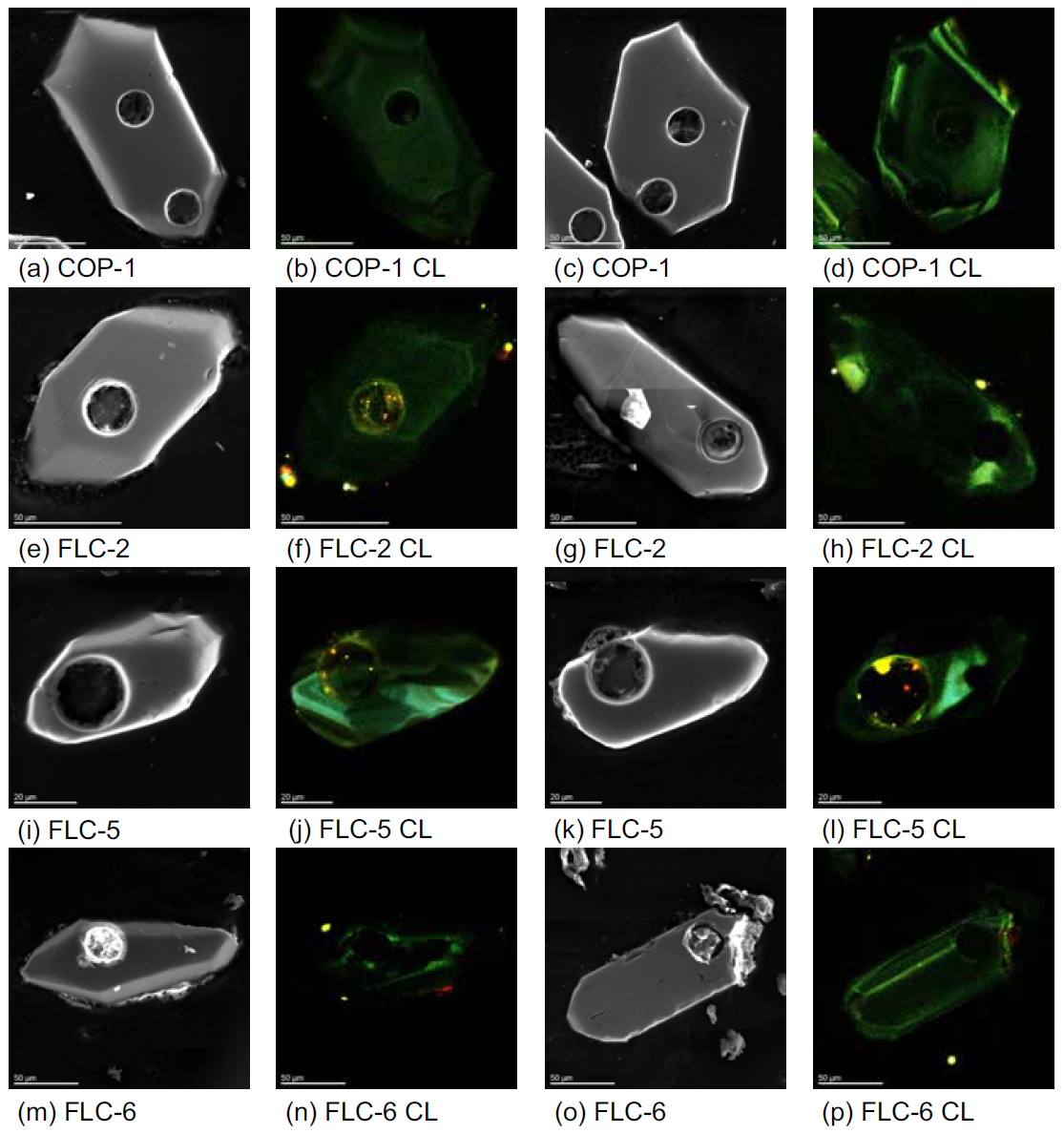 Display large image of Figure A1
Display large image of Figure A1
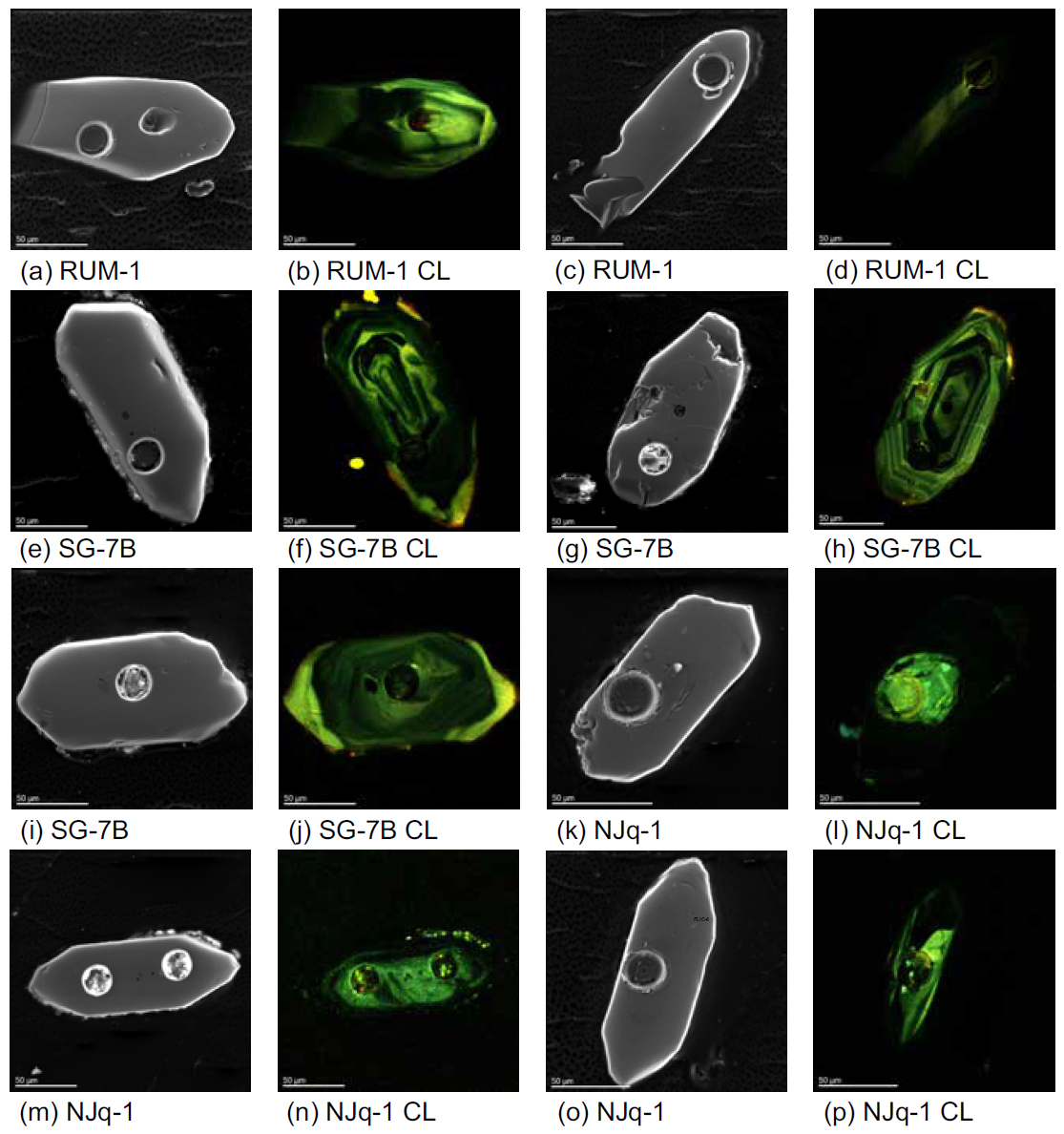 Display large image of Figure A2
Display large image of Figure A2
APPENDIX B
 Display large image of Table B1
Display large image of Table B1
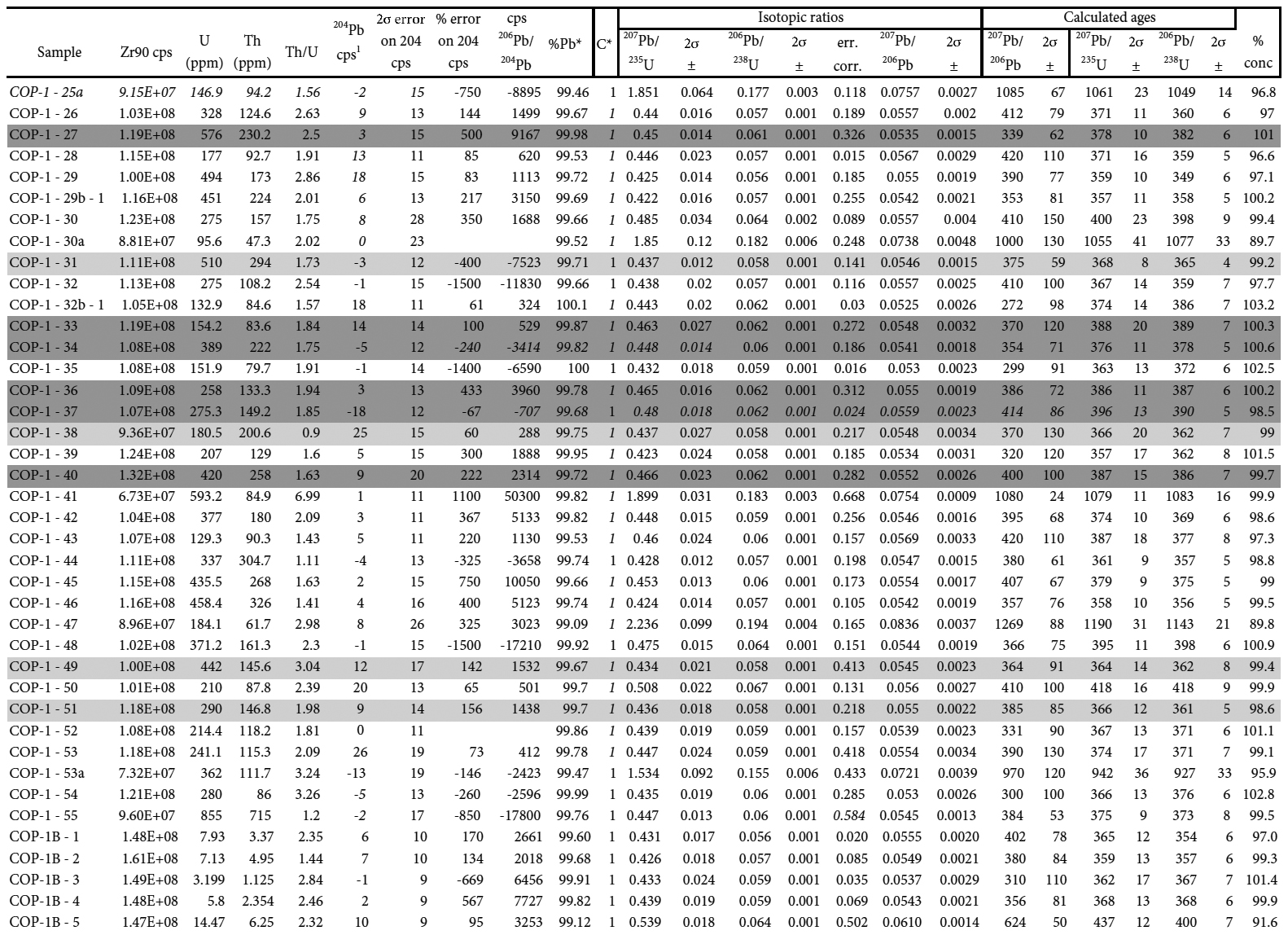 Display large image of Table B1
Display large image of Table B1
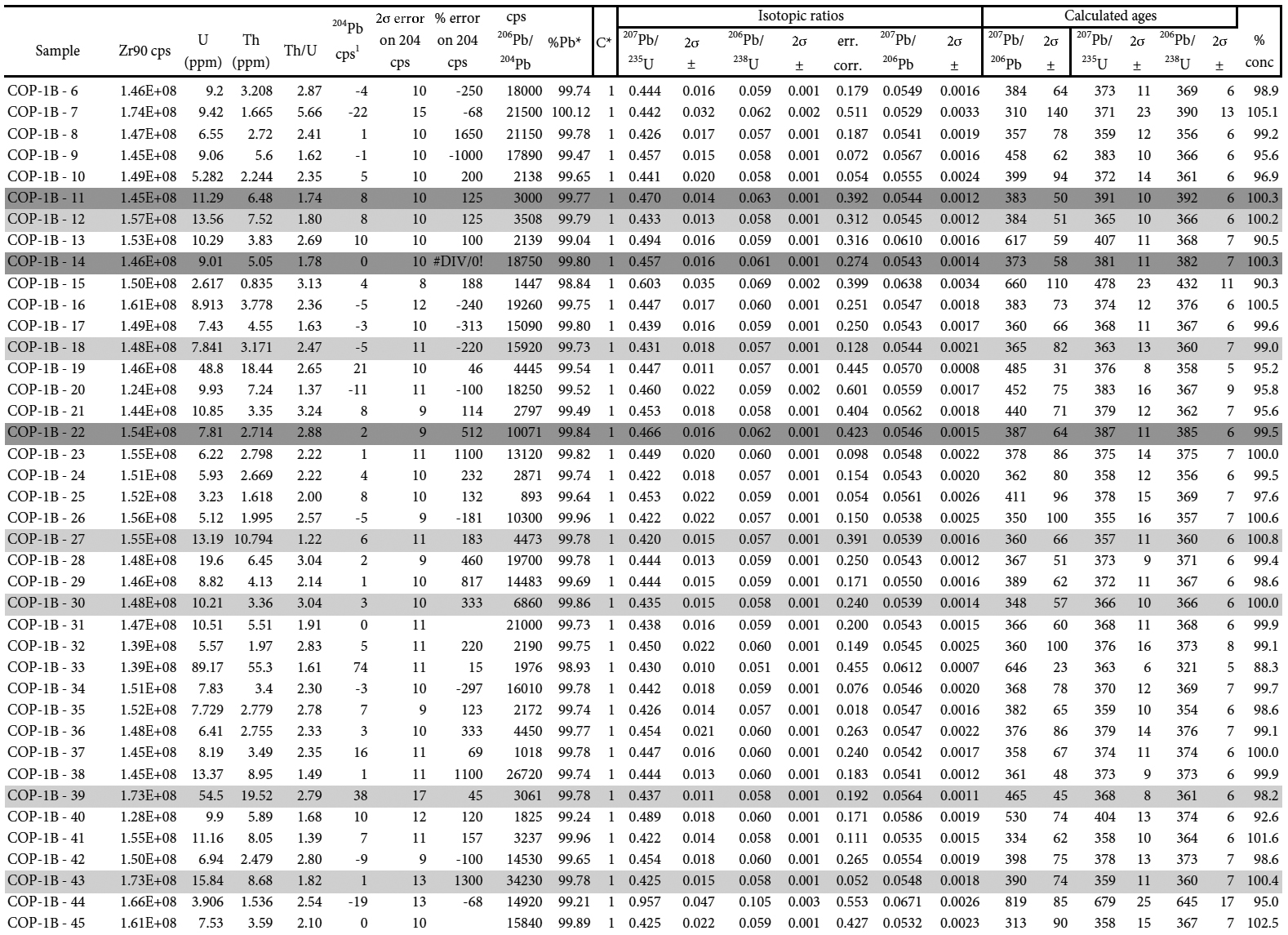 Display large image of Table B1
Display large image of Table B1
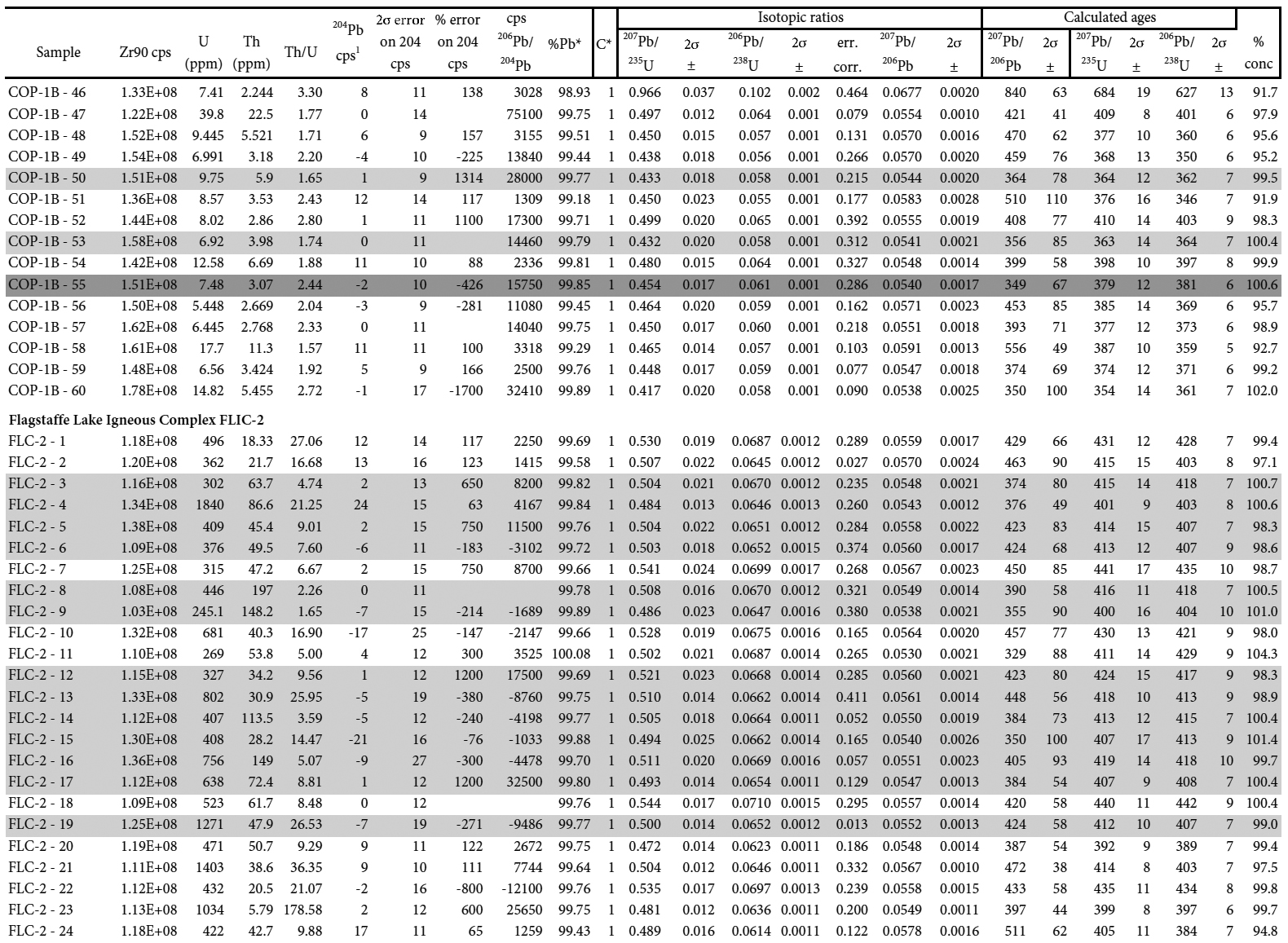 Display large image of Table B1
Display large image of Table B1
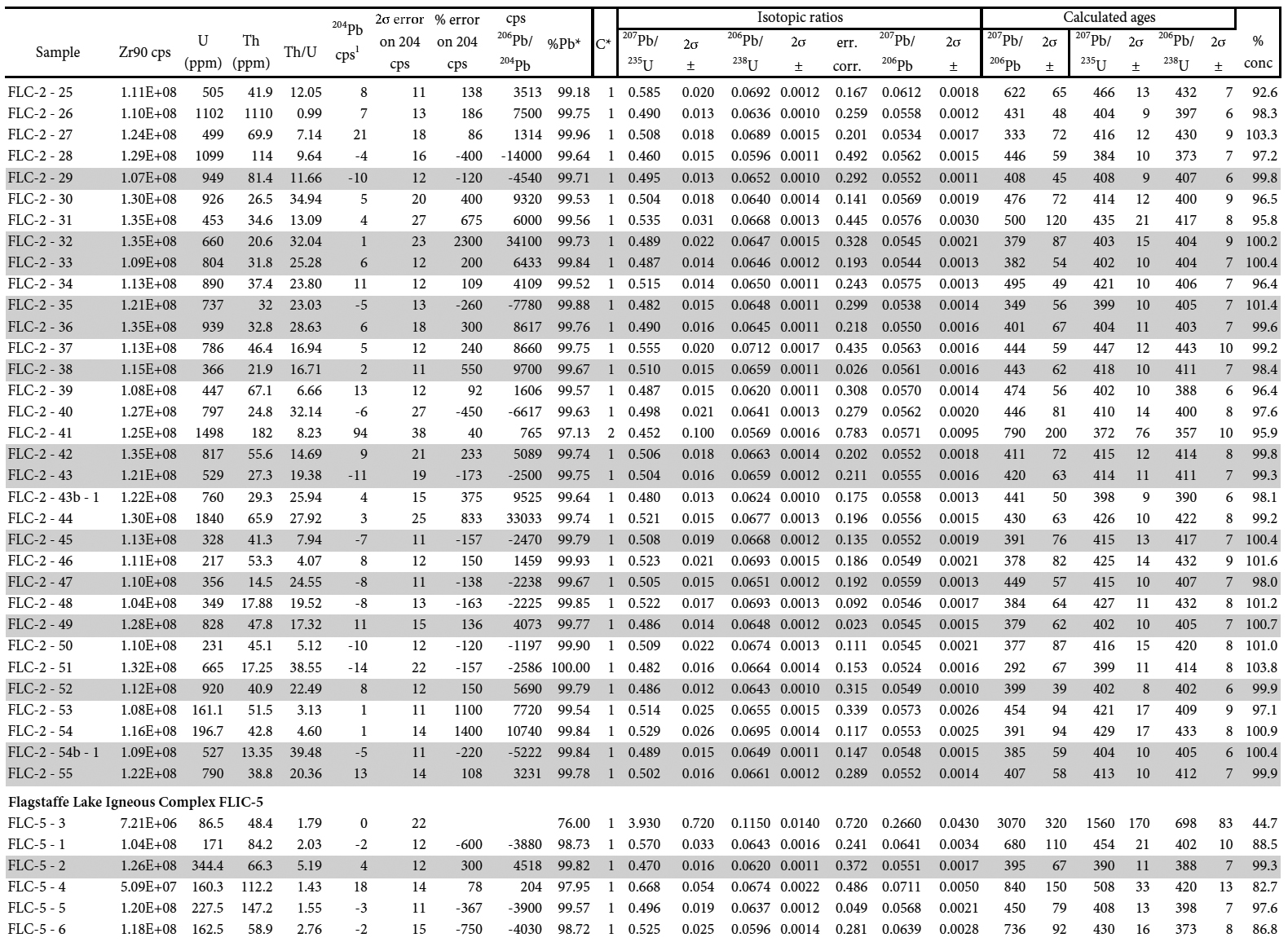 Display large image of Table B1
Display large image of Table B1
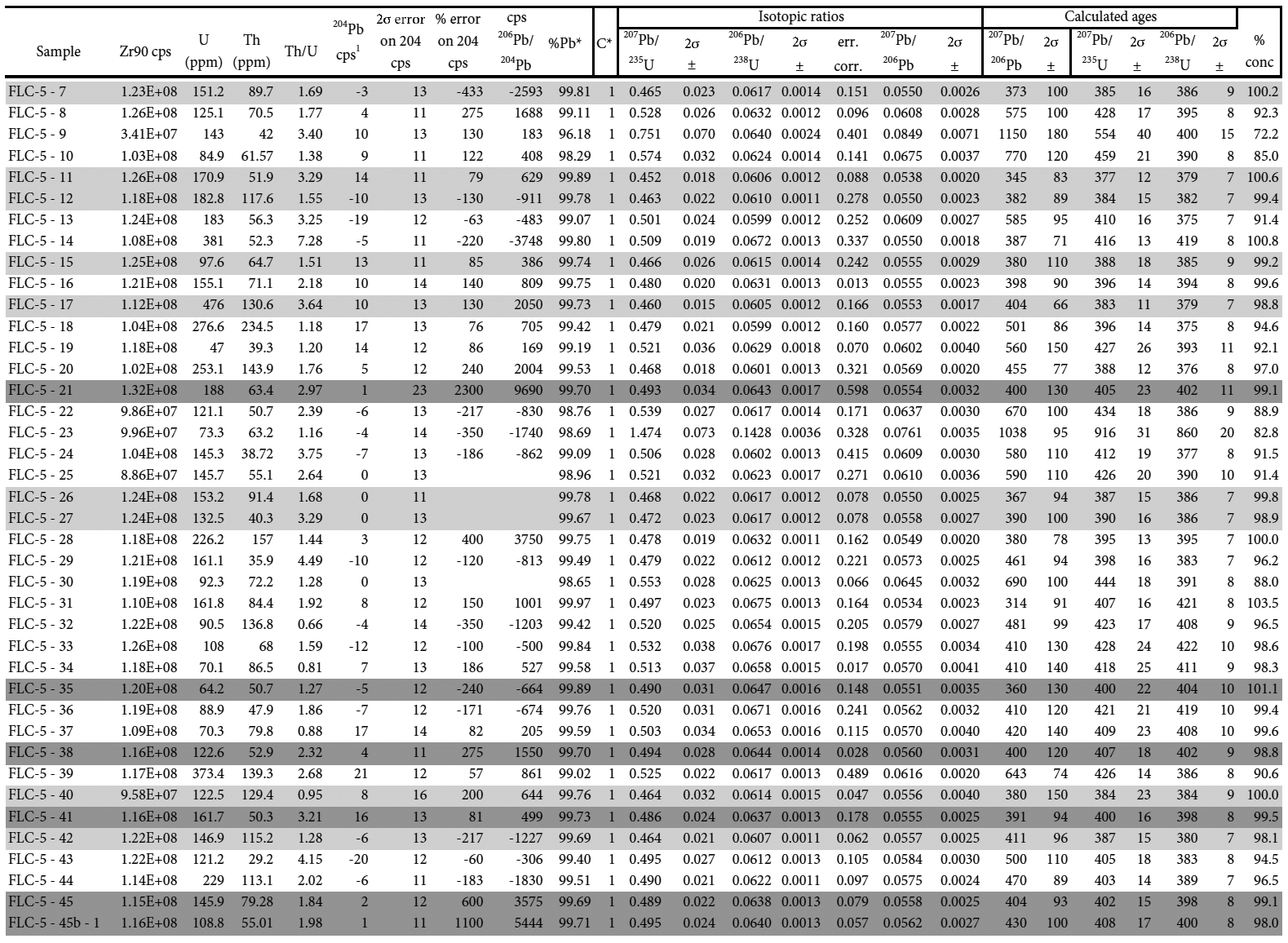 Display large image of Table B1
Display large image of Table B1
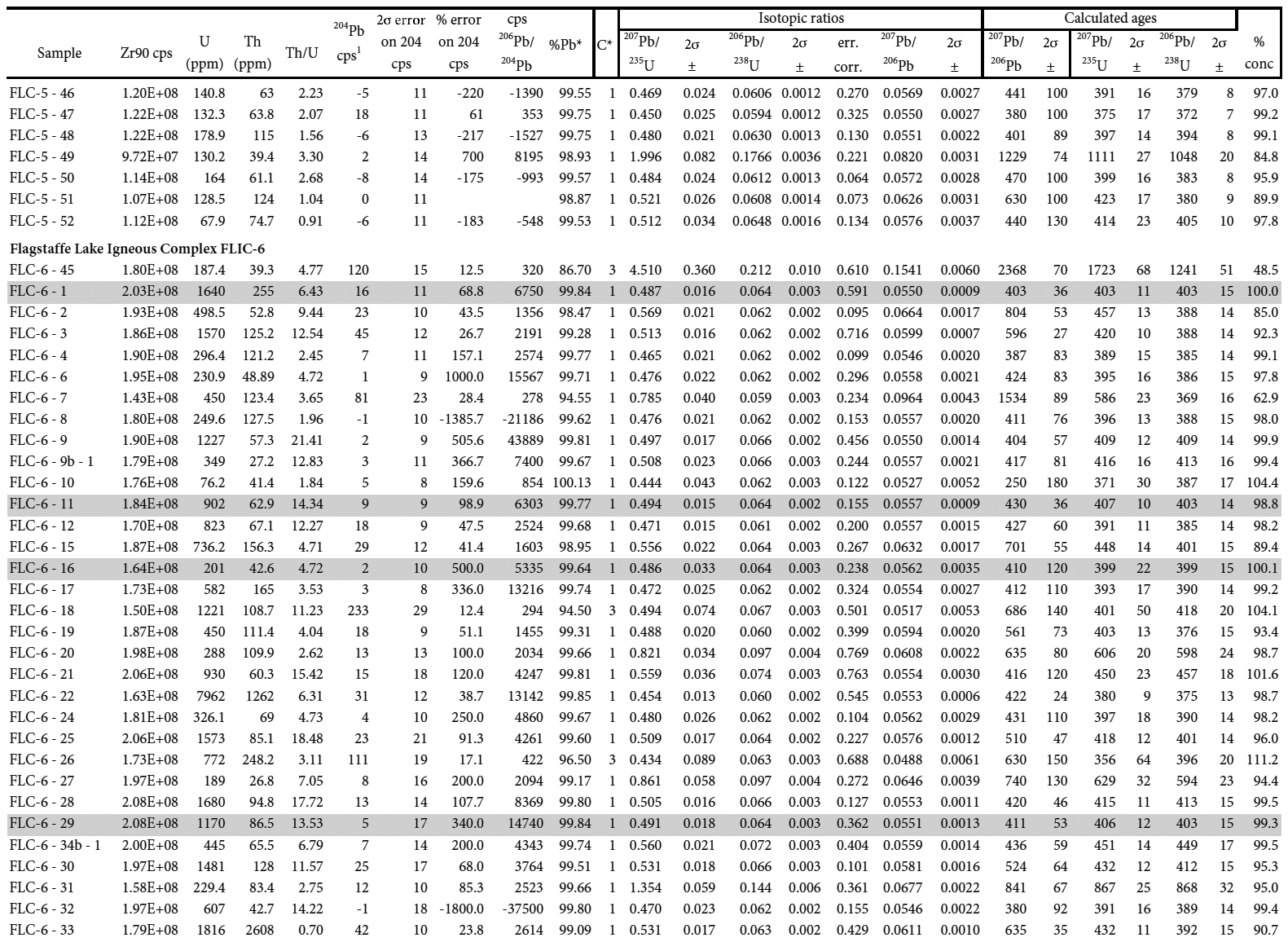 Display large image of Table B1
Display large image of Table B1
 Display large image of Table B1
Display large image of Table B1
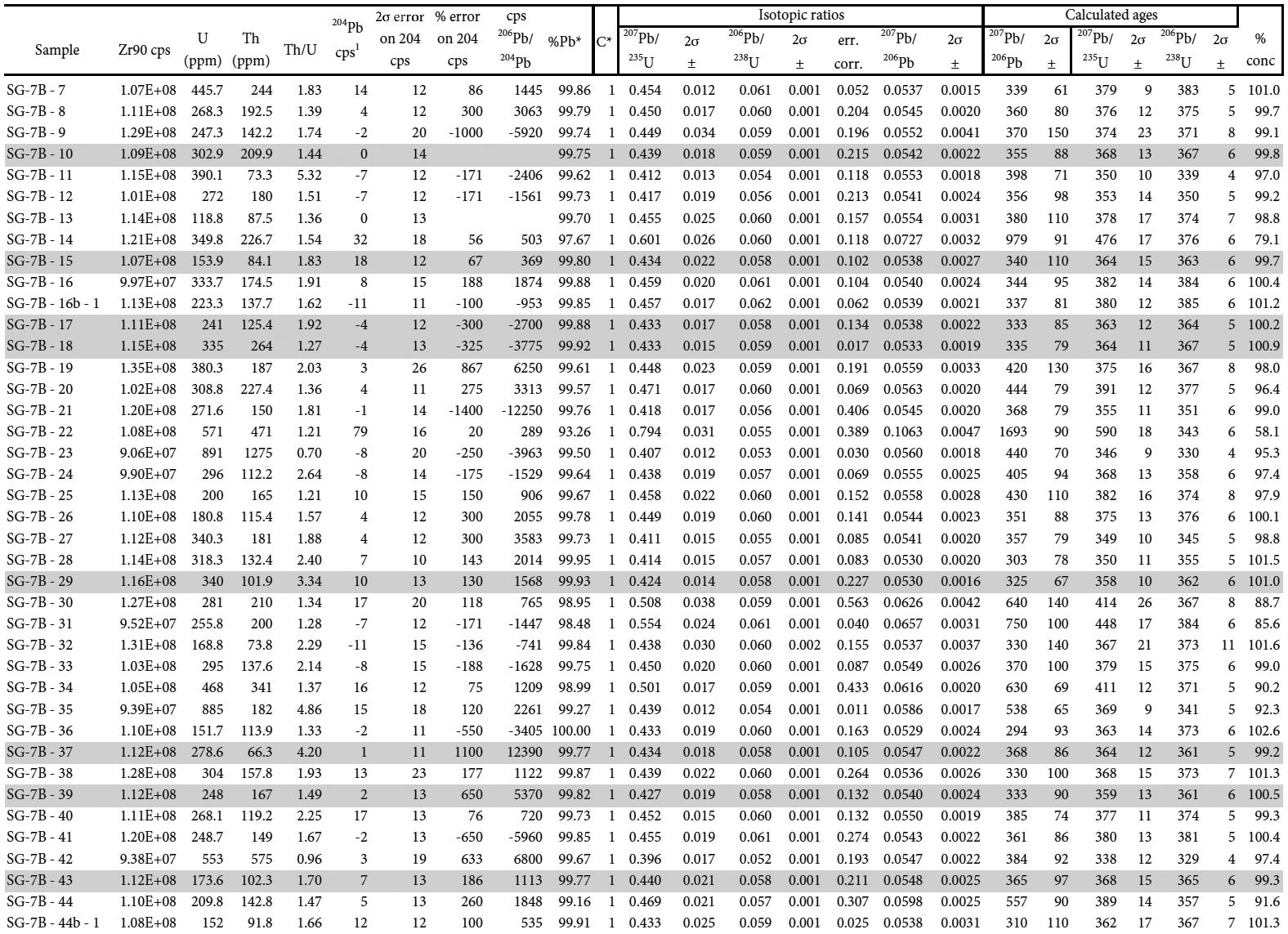 Display large image of Table B1
Display large image of Table B1
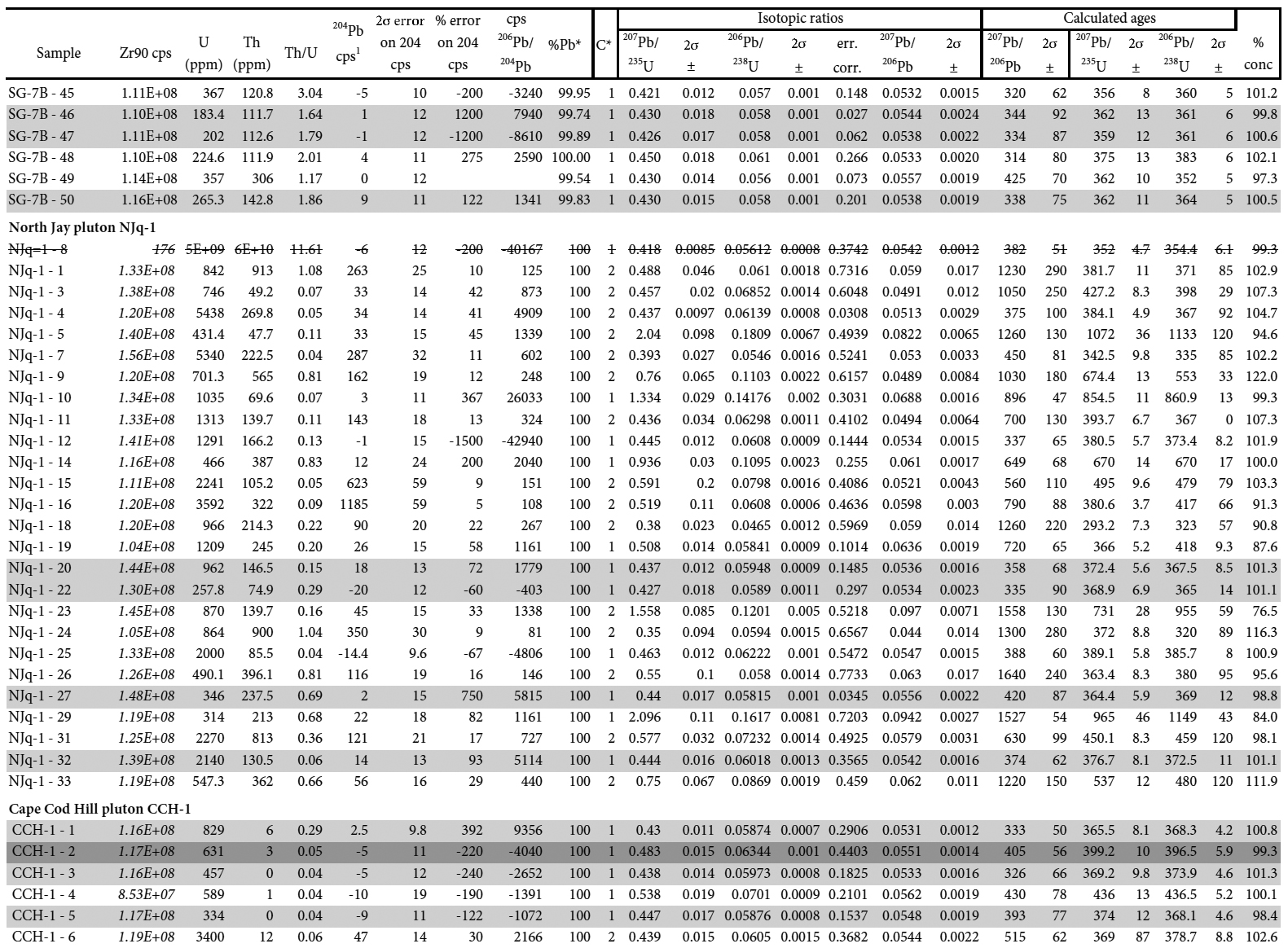 Display large image of Table B1
Display large image of Table B1
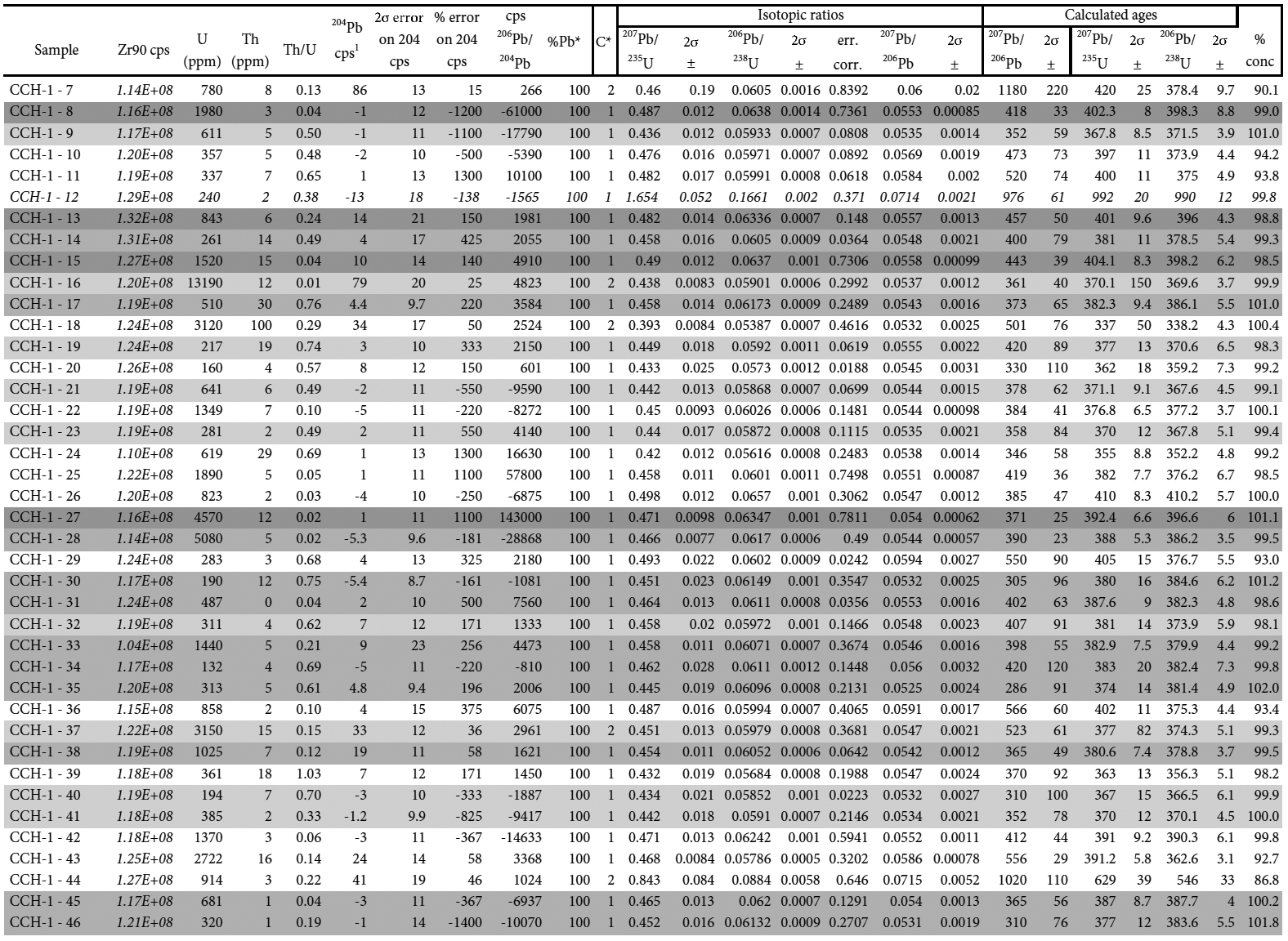 Display large image of Table B1
Display large image of Table B1
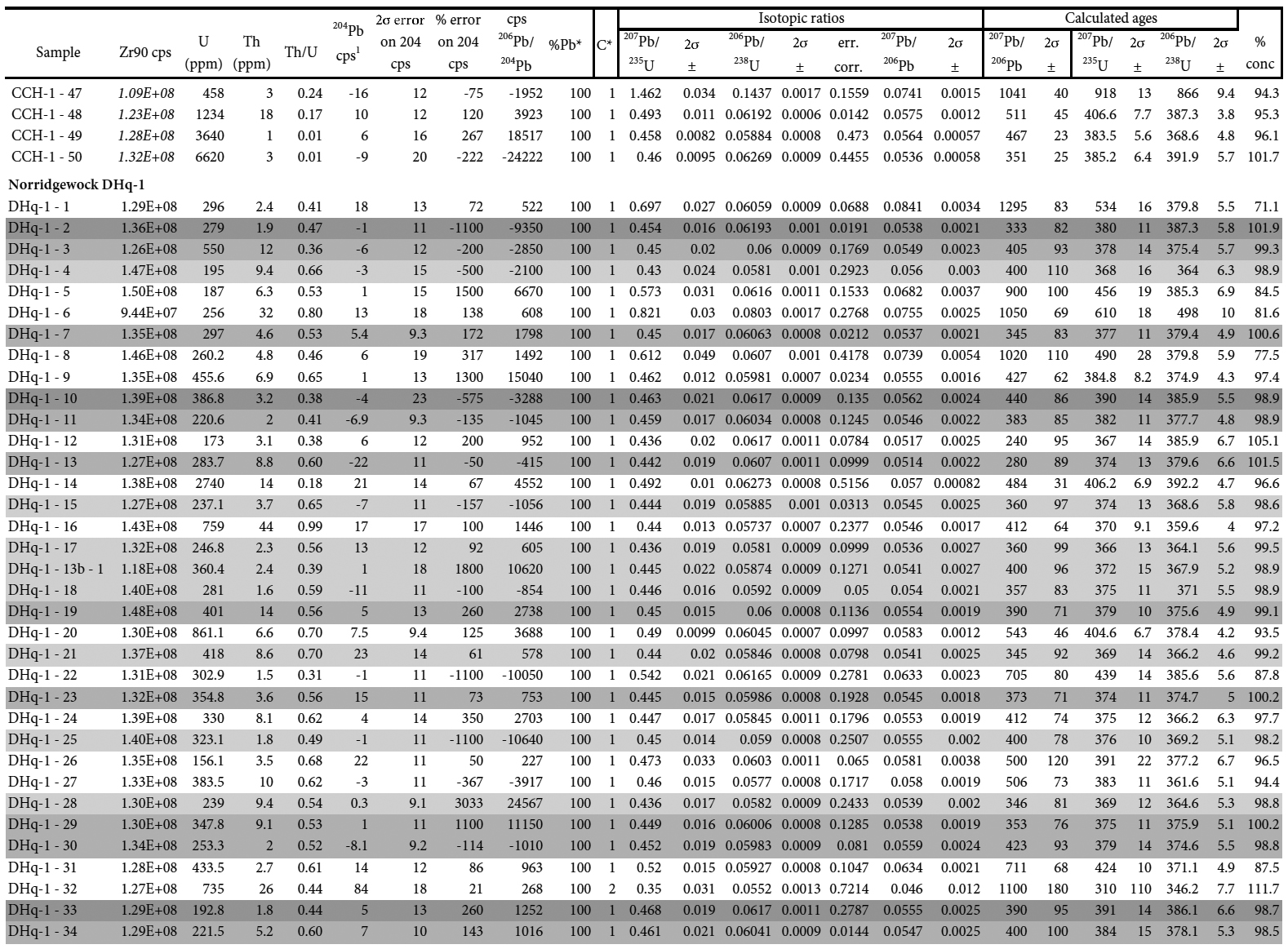 Display large image of Table B1
Display large image of Table B1
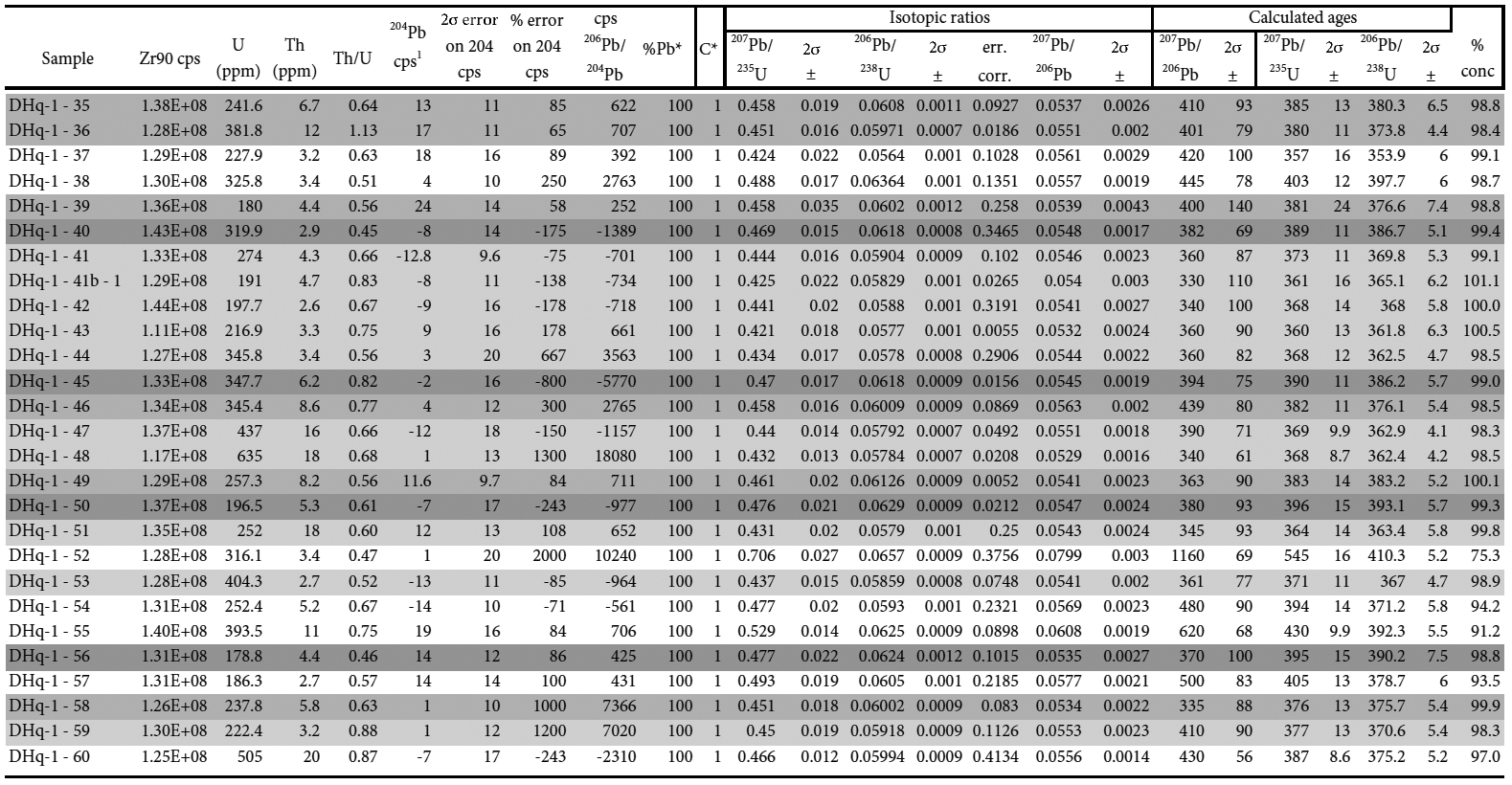 Display large image of Table B1
Display large image of Table B1
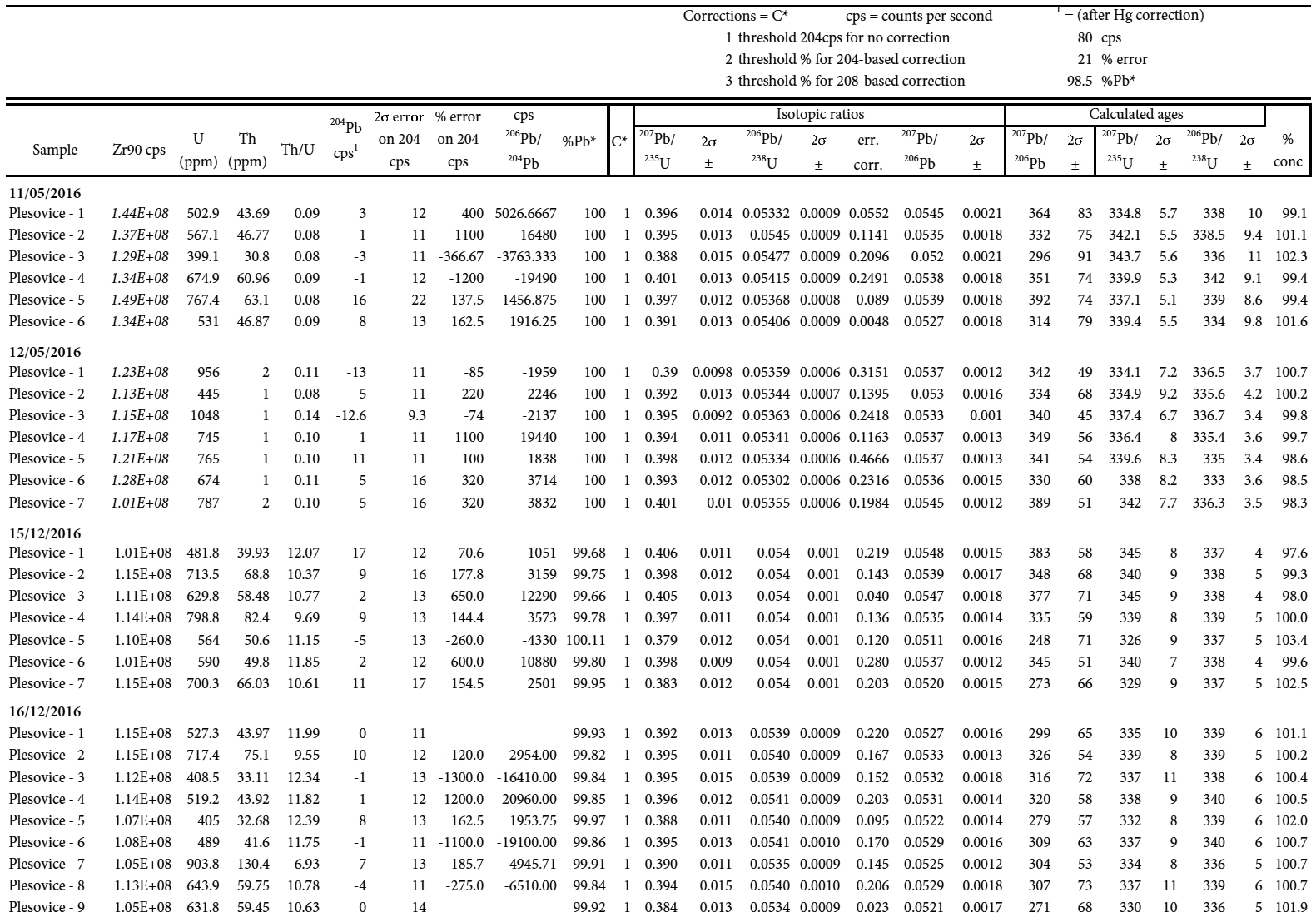 Display large image of Table B2
Display large image of Table B2
 Display large image of Table B2
Display large image of Table B2
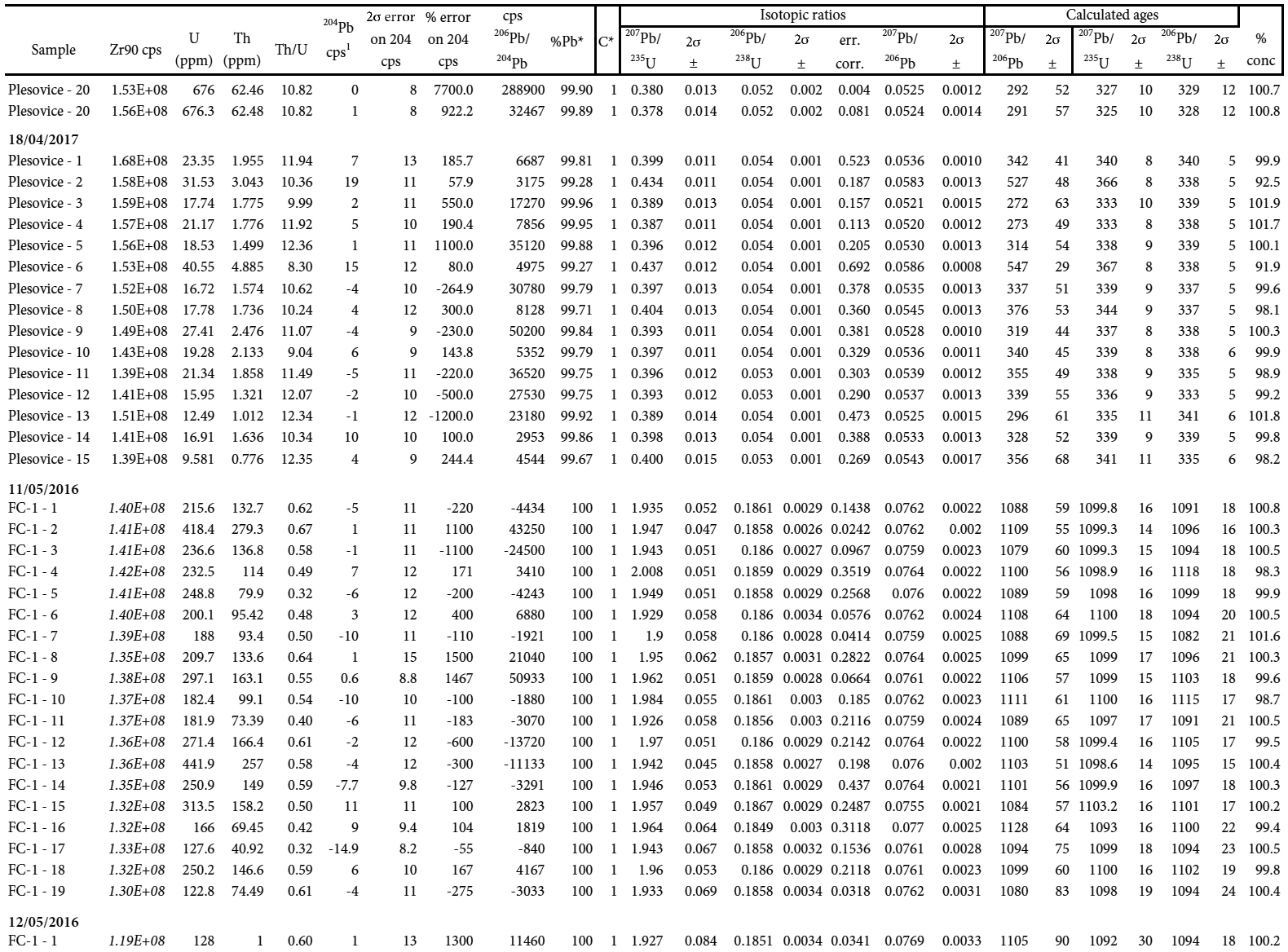 Display large image of Table B2
Display large image of Table B2
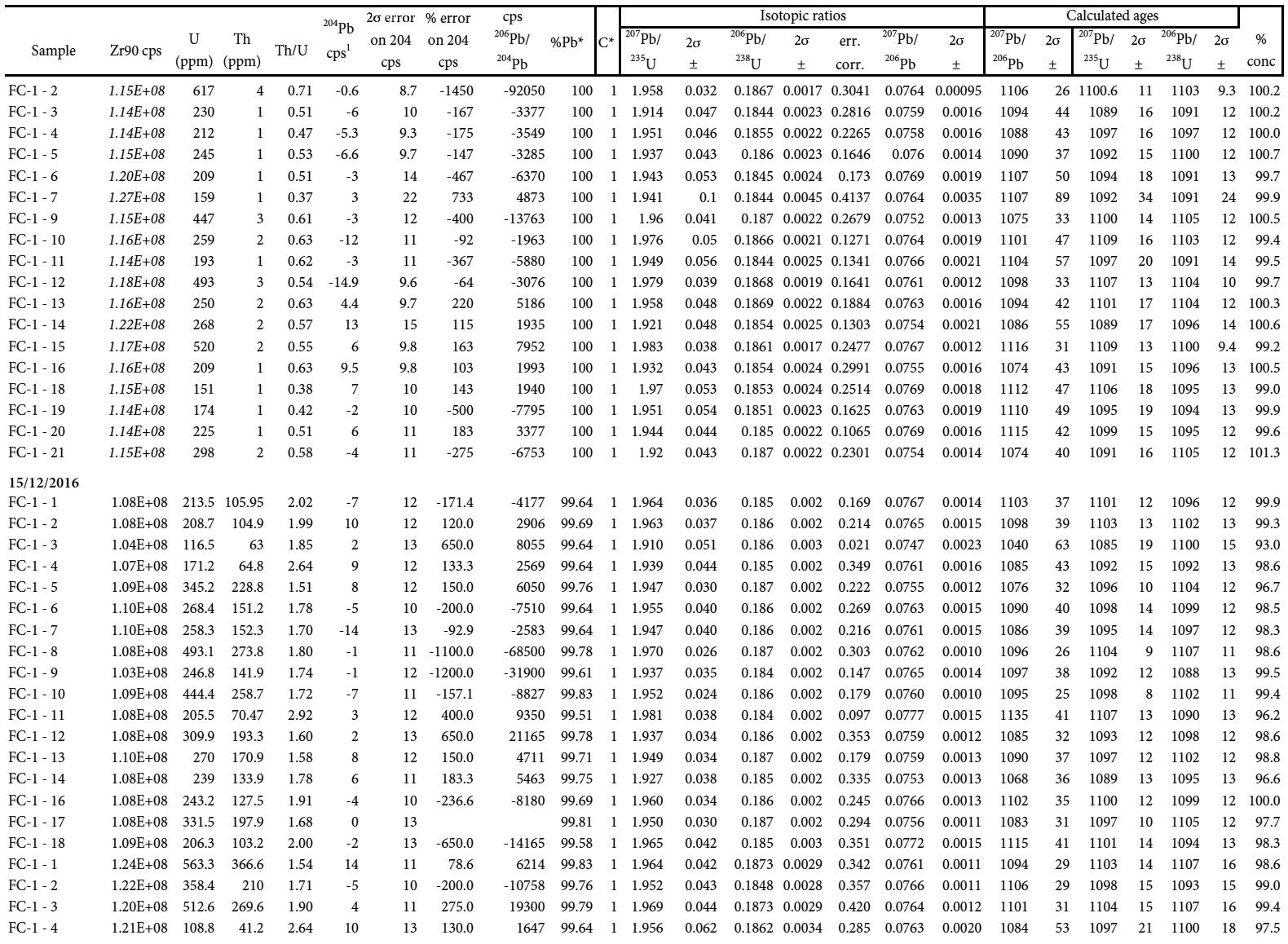 Display large image of Table B2
Display large image of Table B2
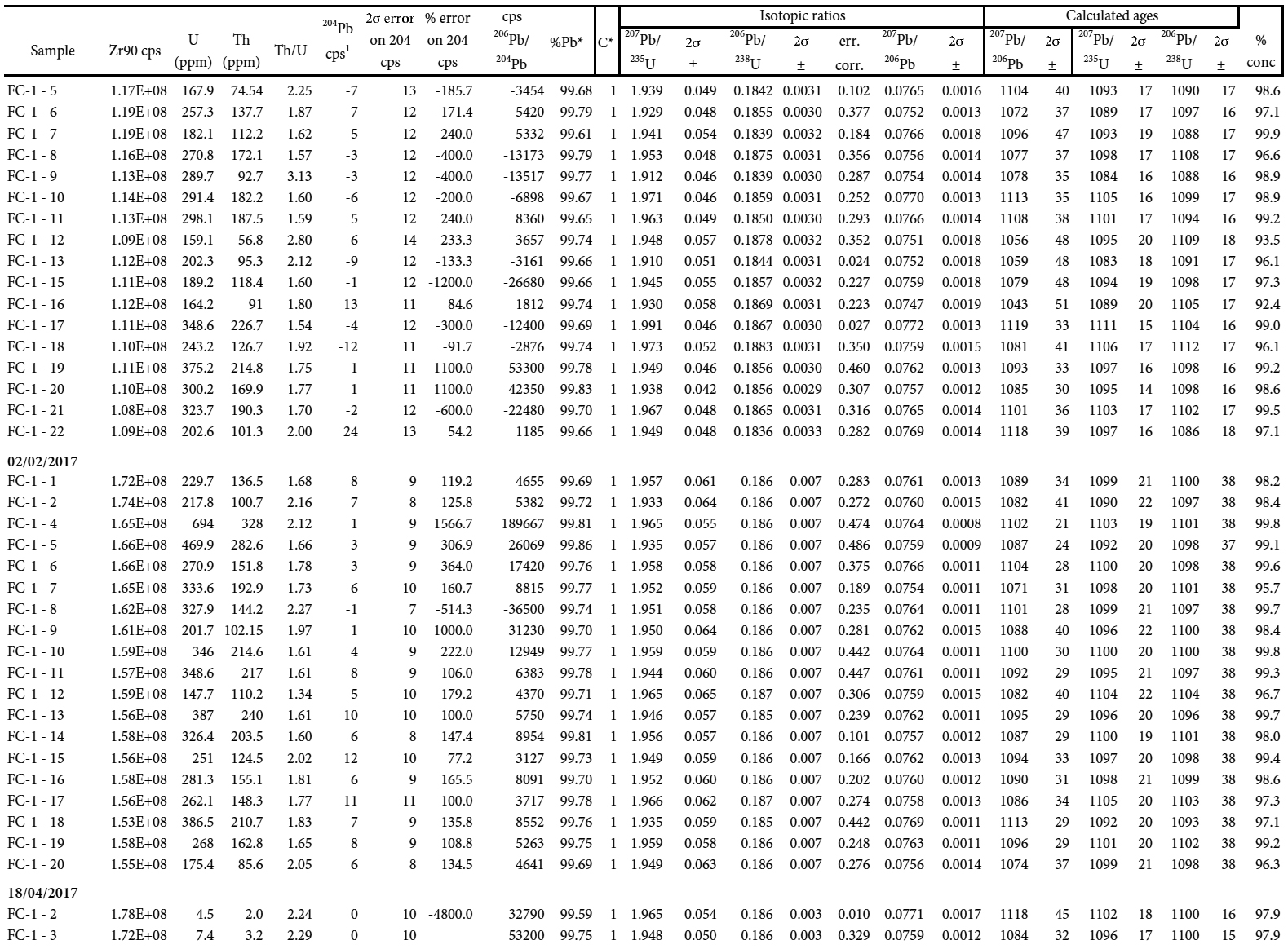 Display large image of Table B2
Display large image of Table B2
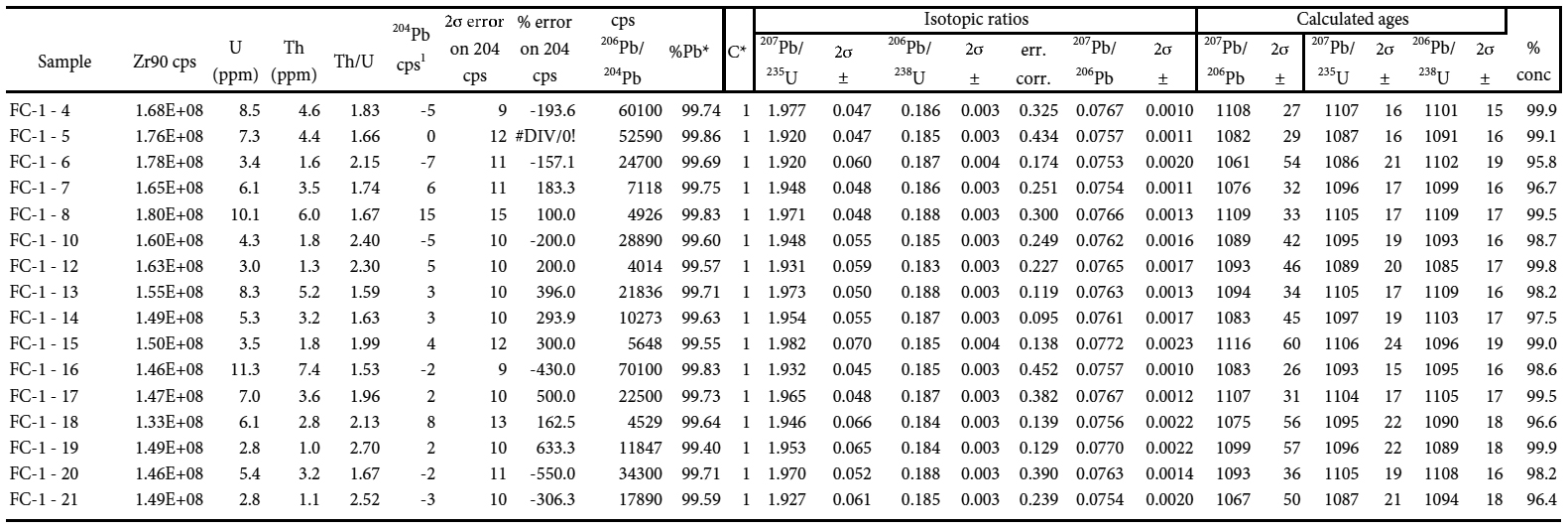 Display large image of Table B2
Display large image of Table B2